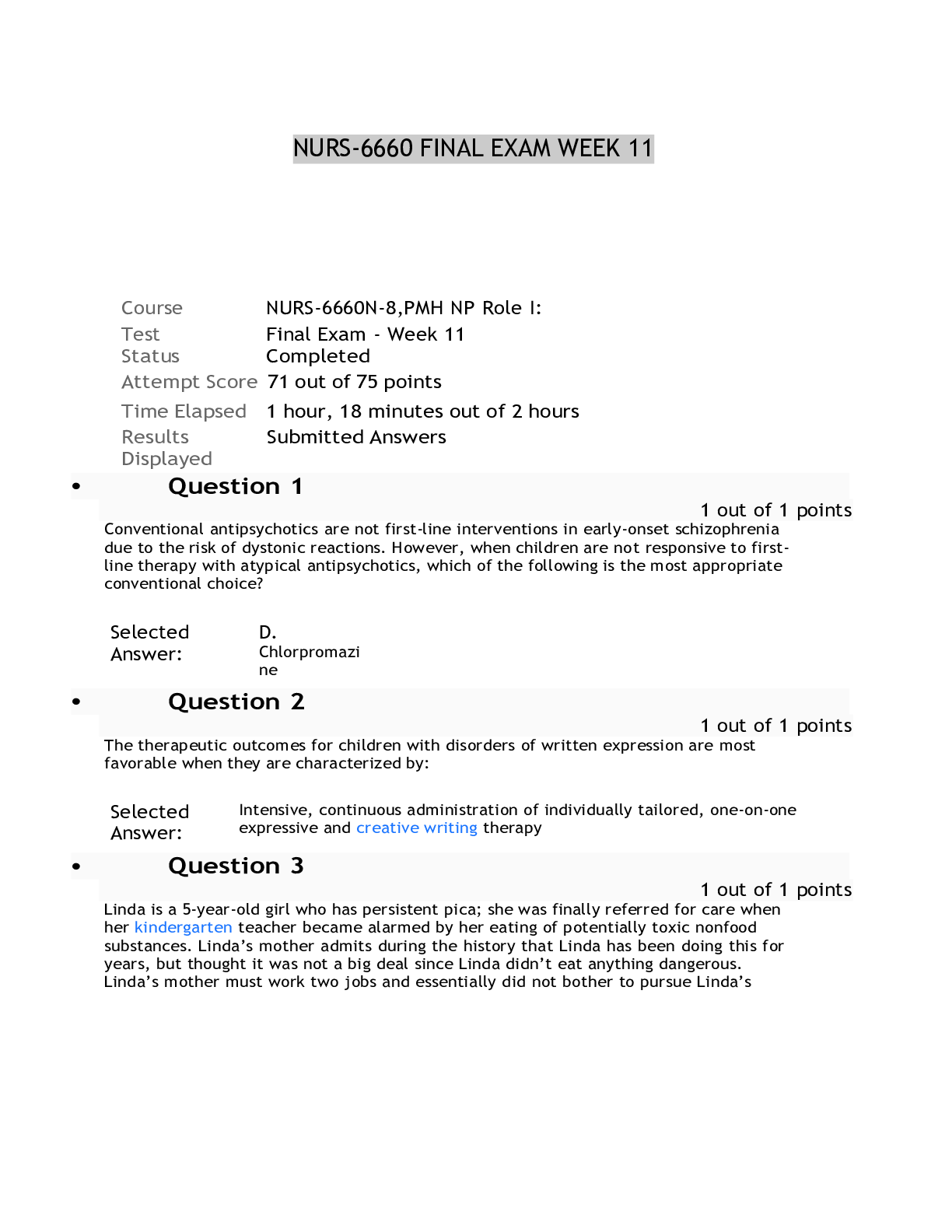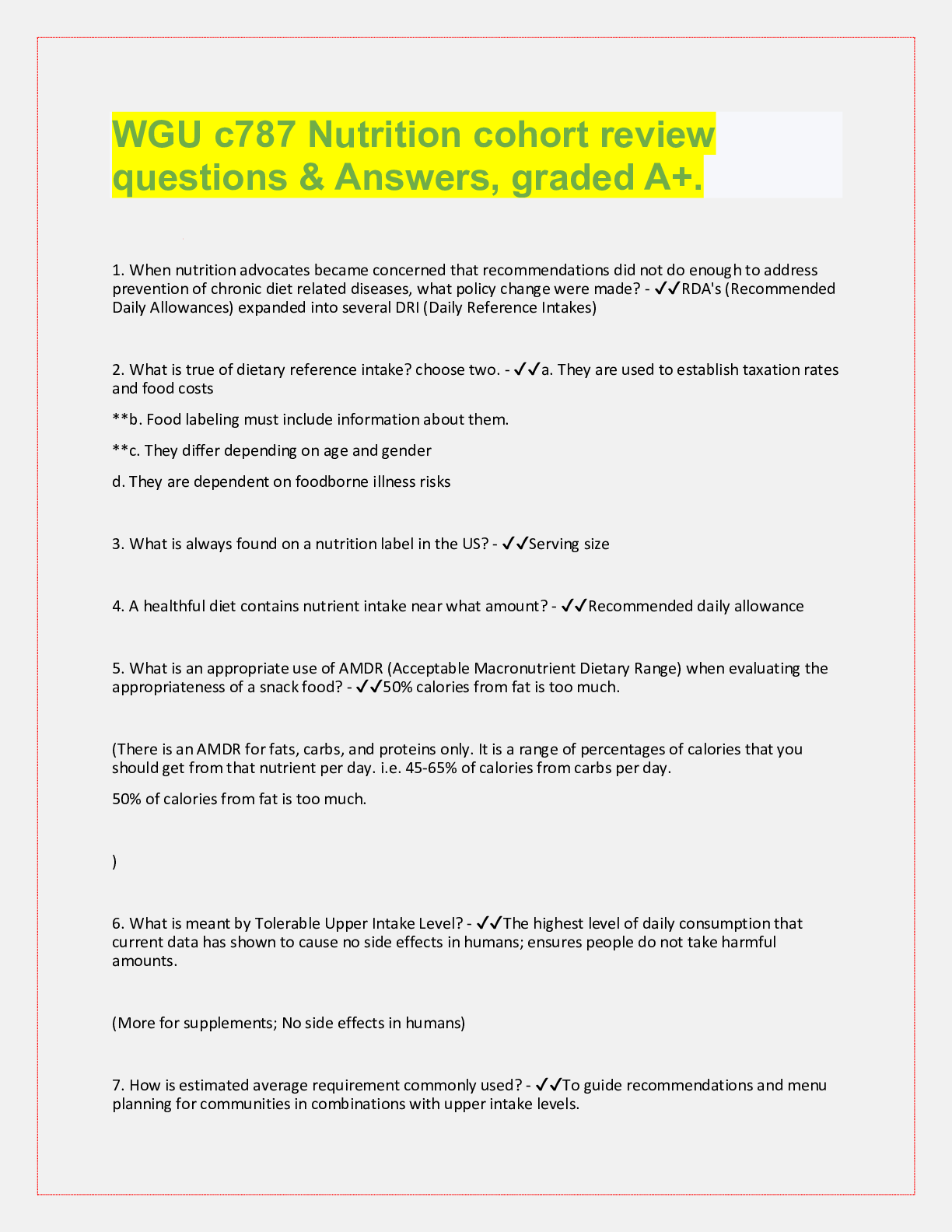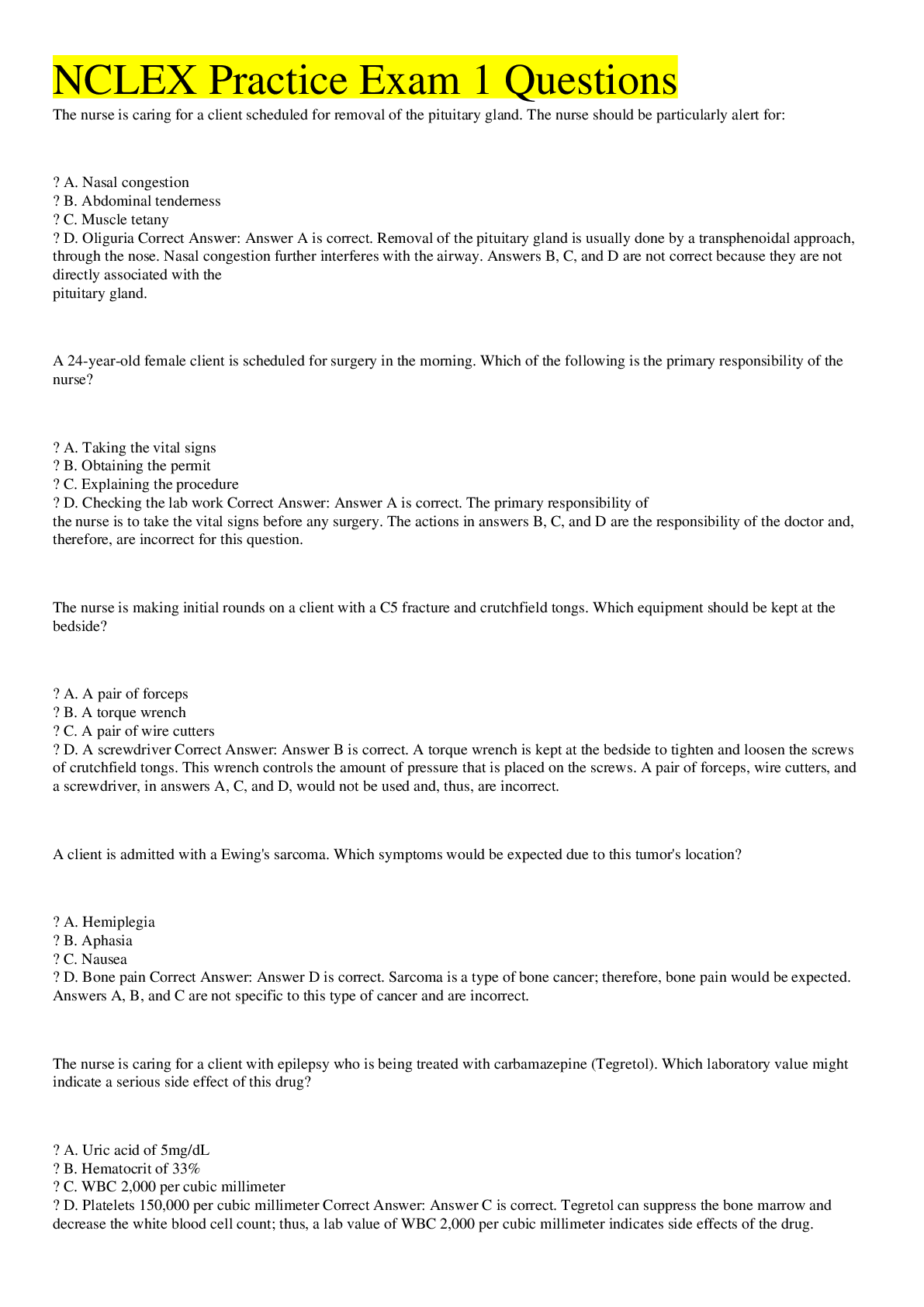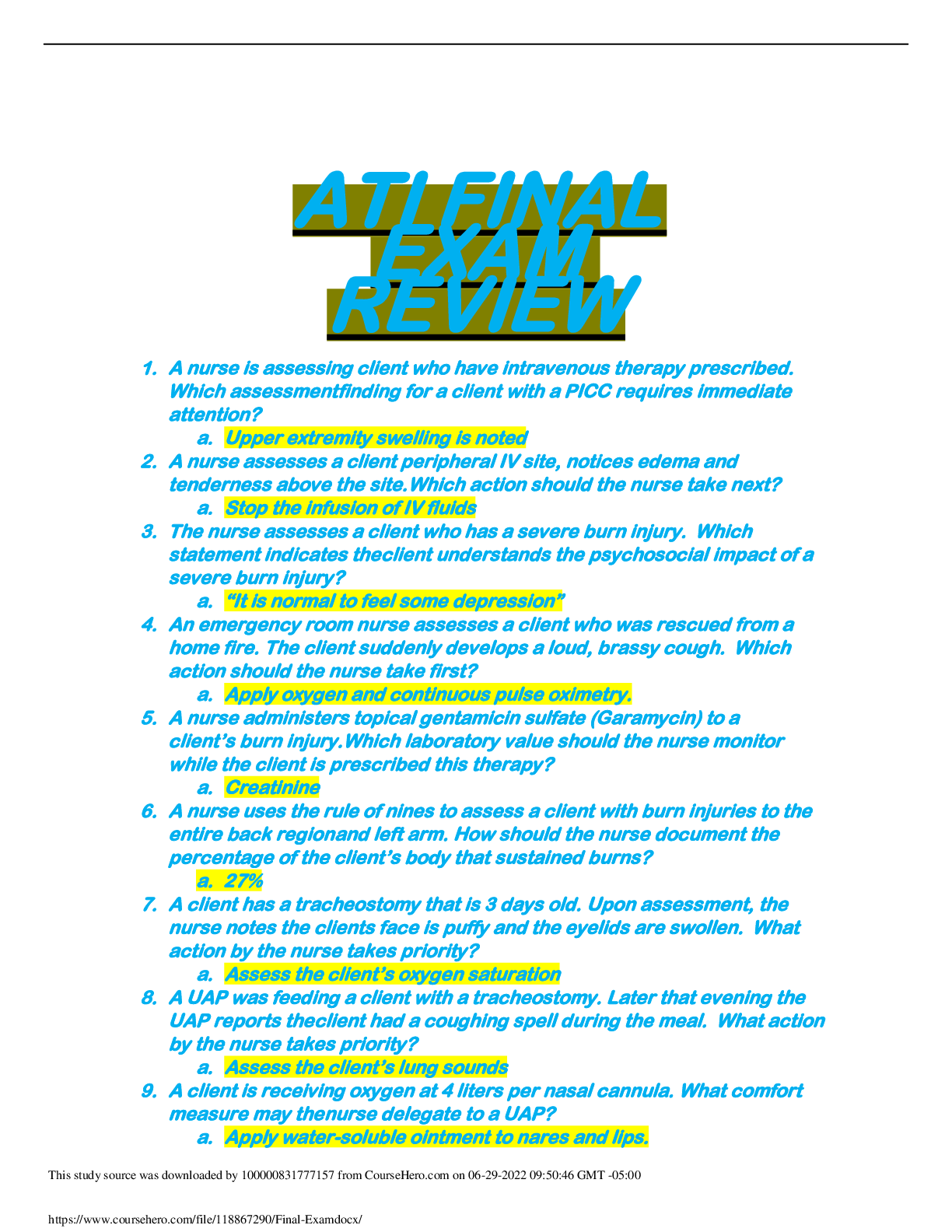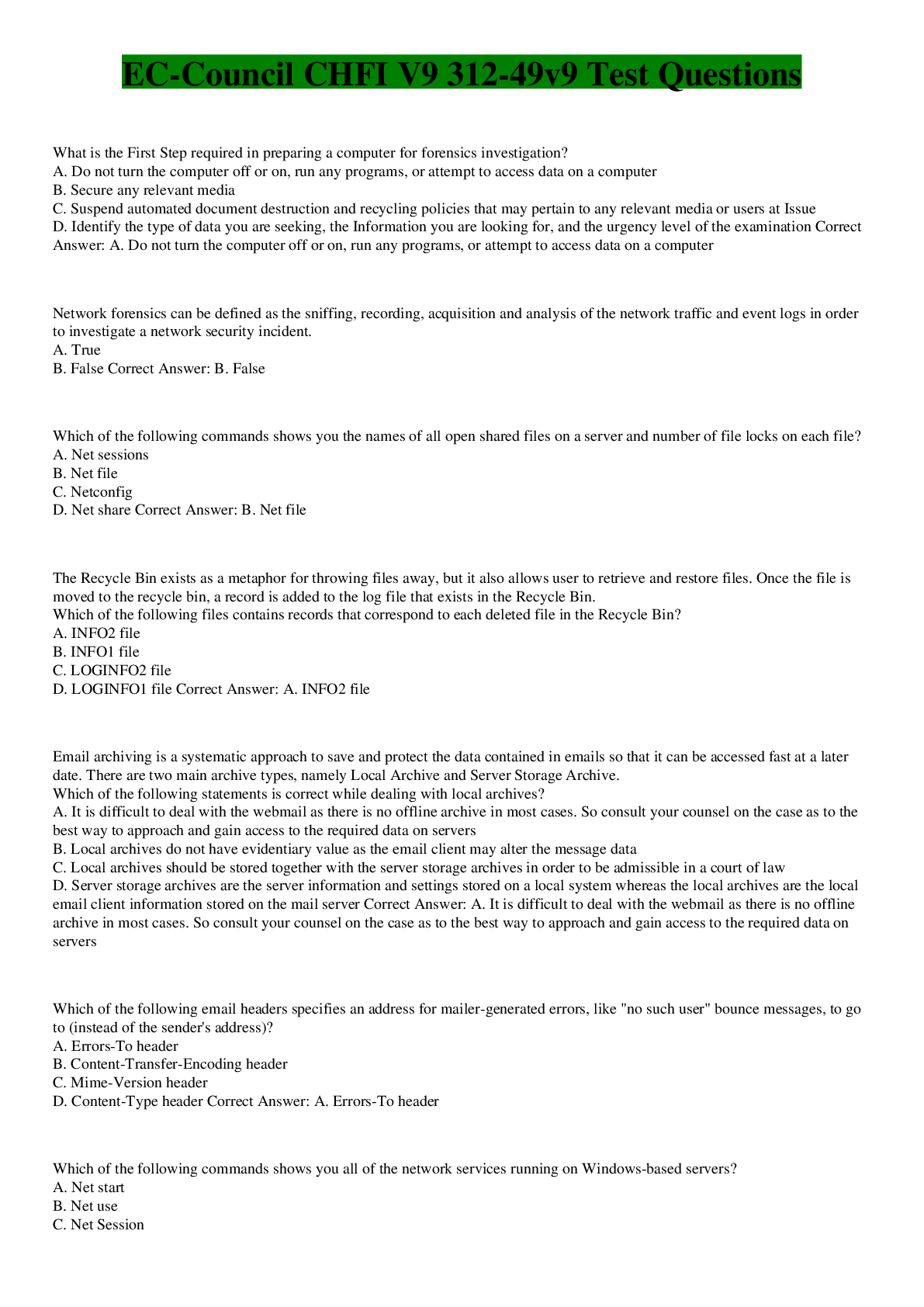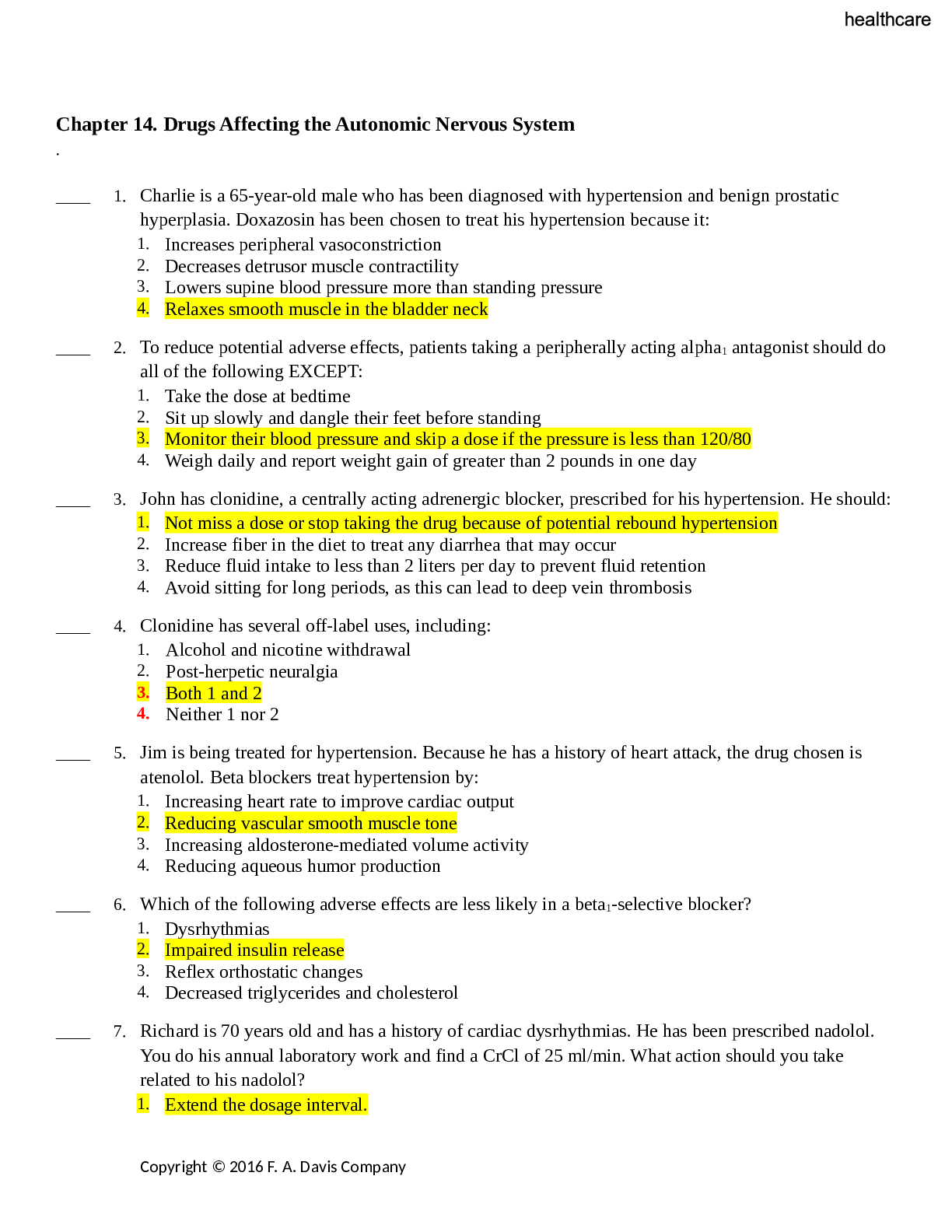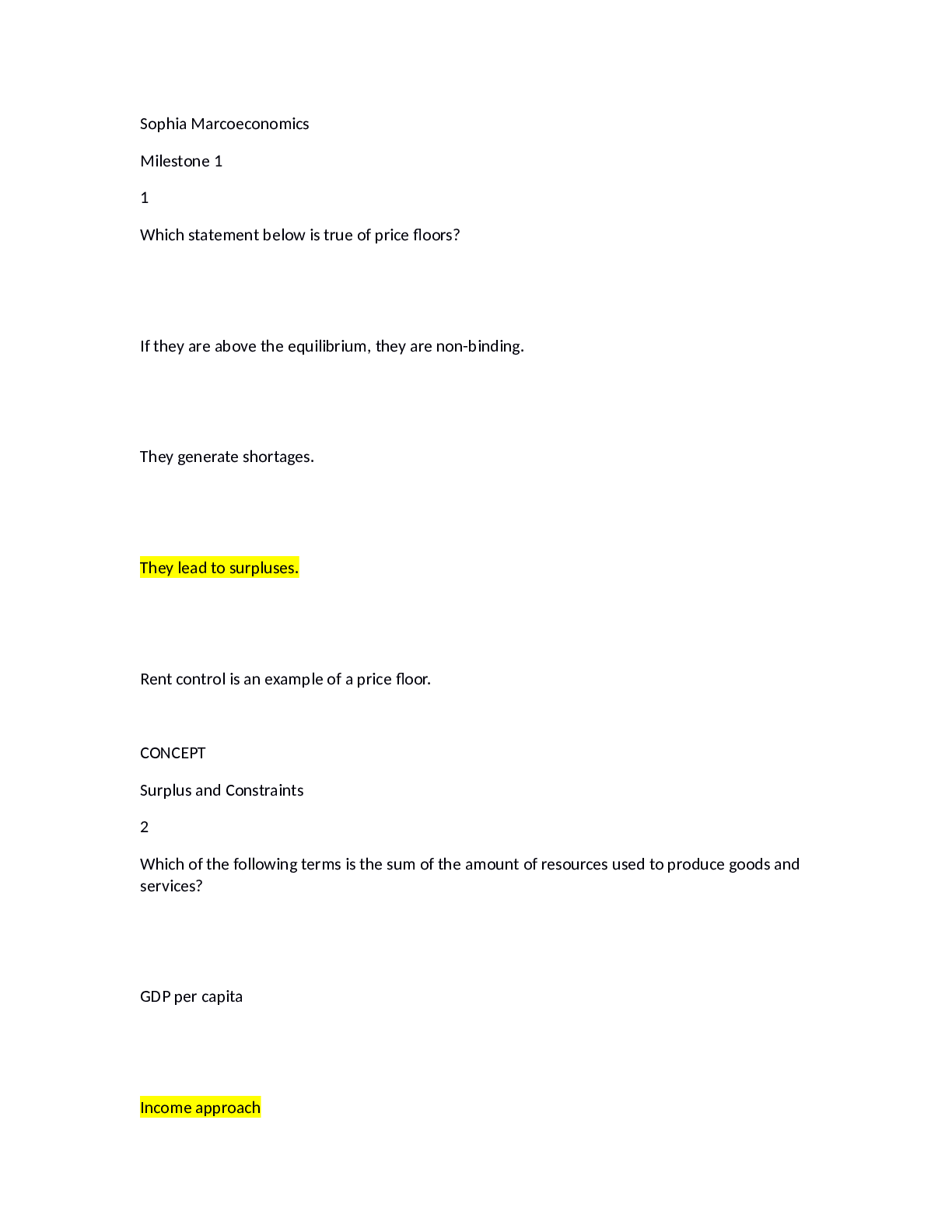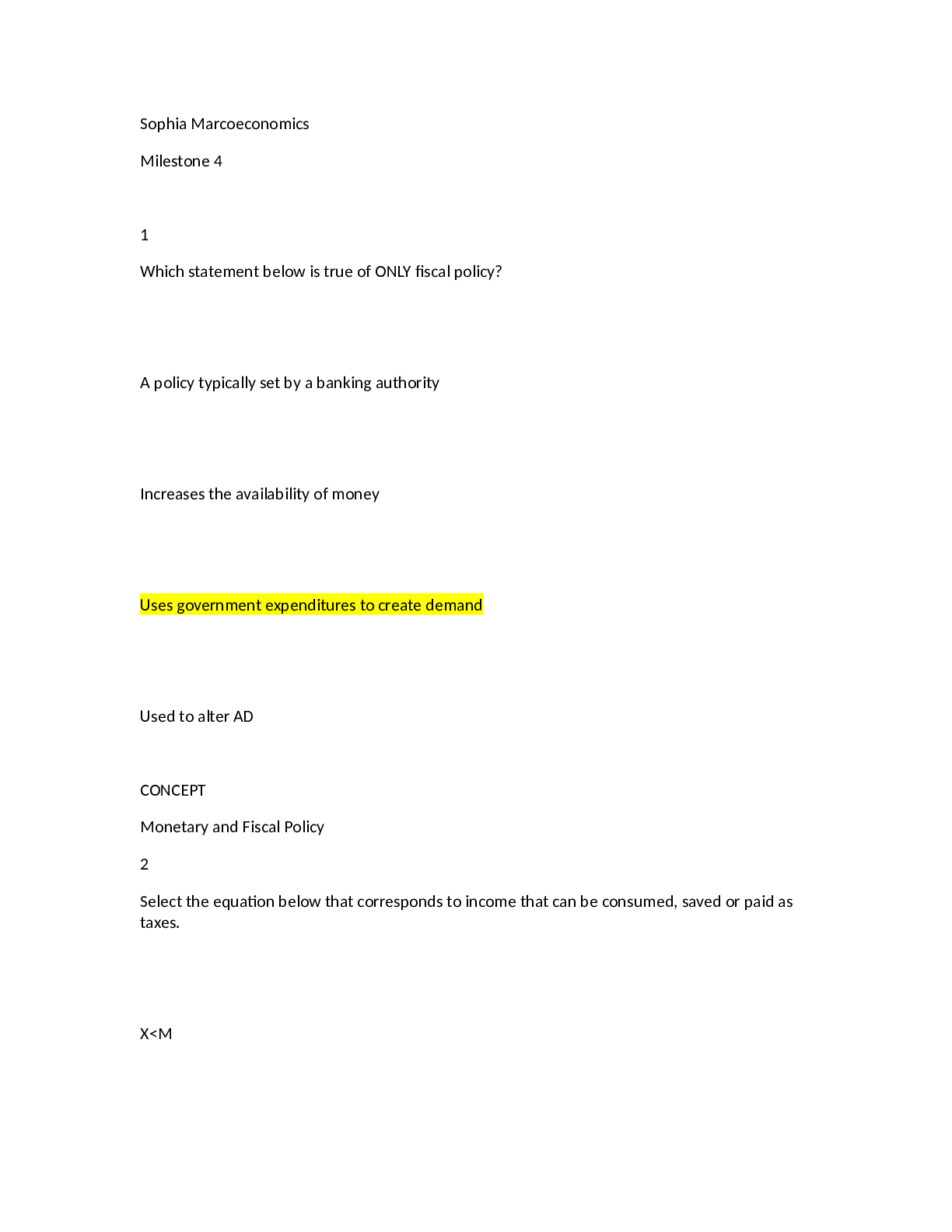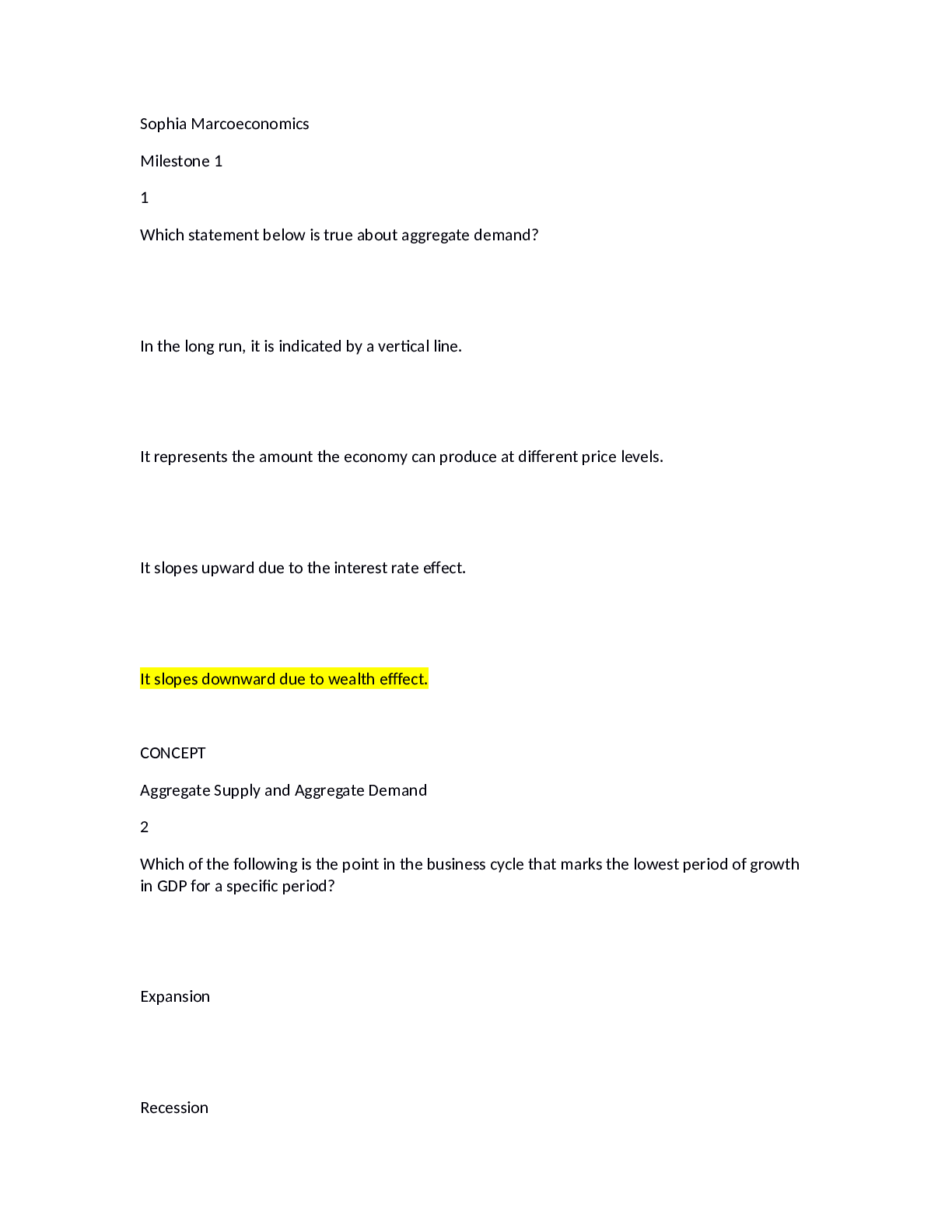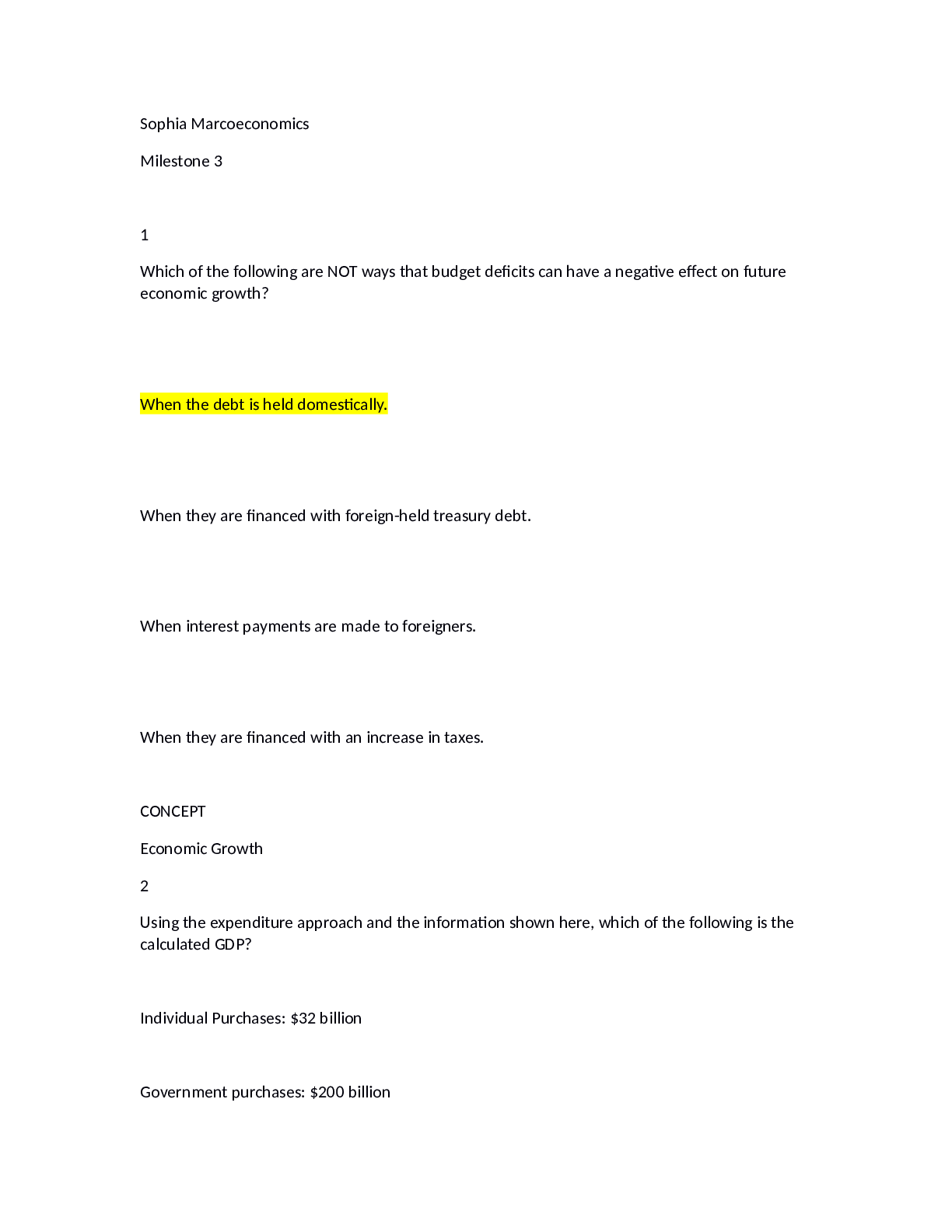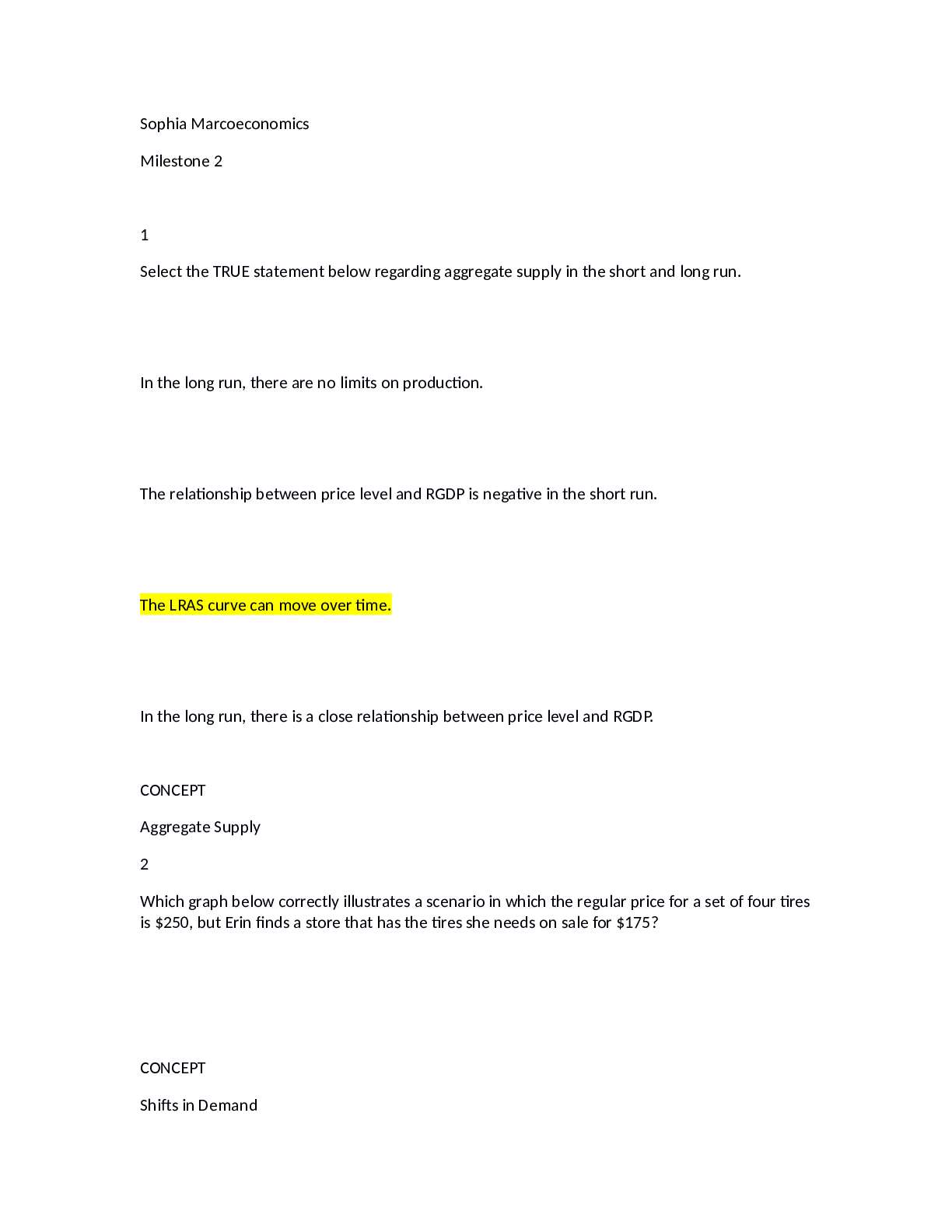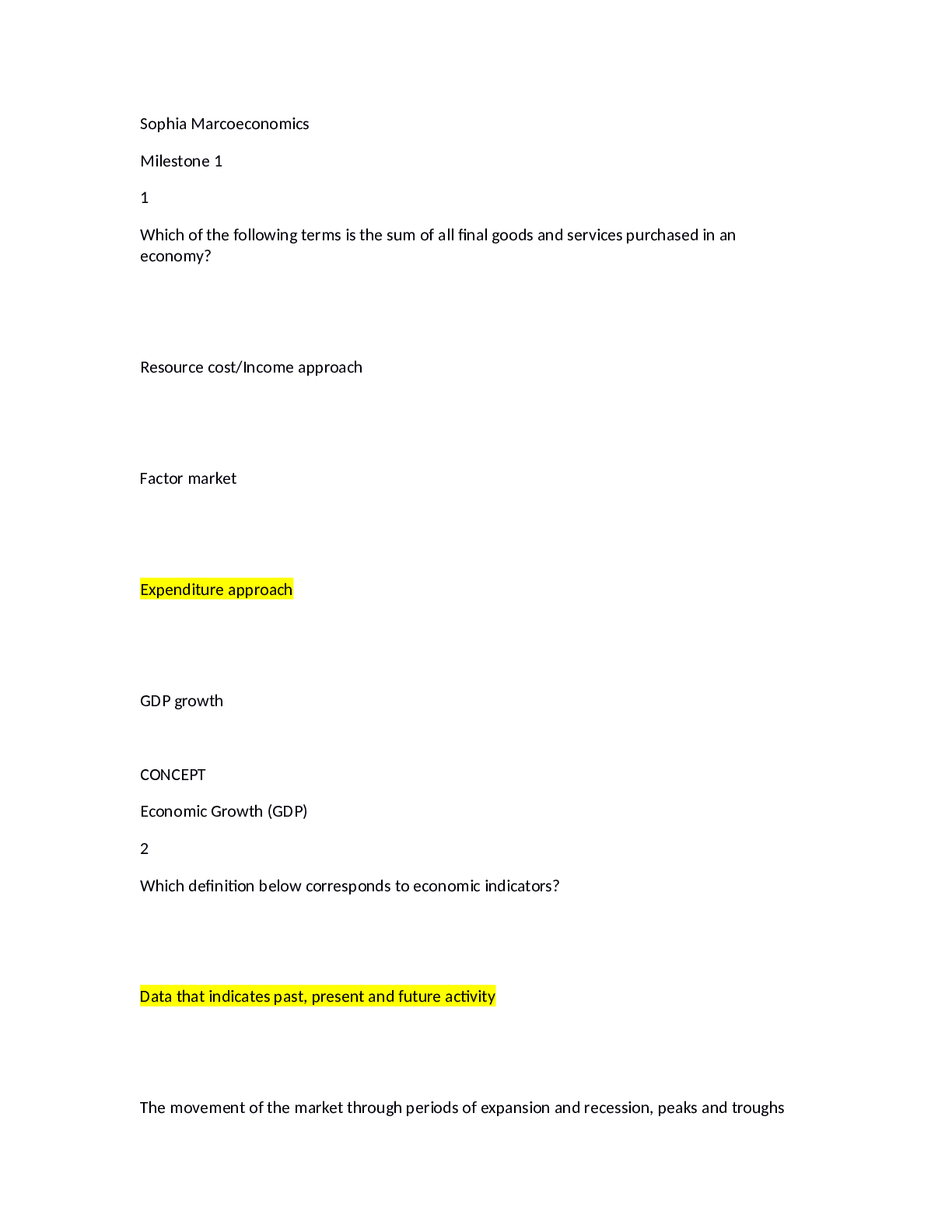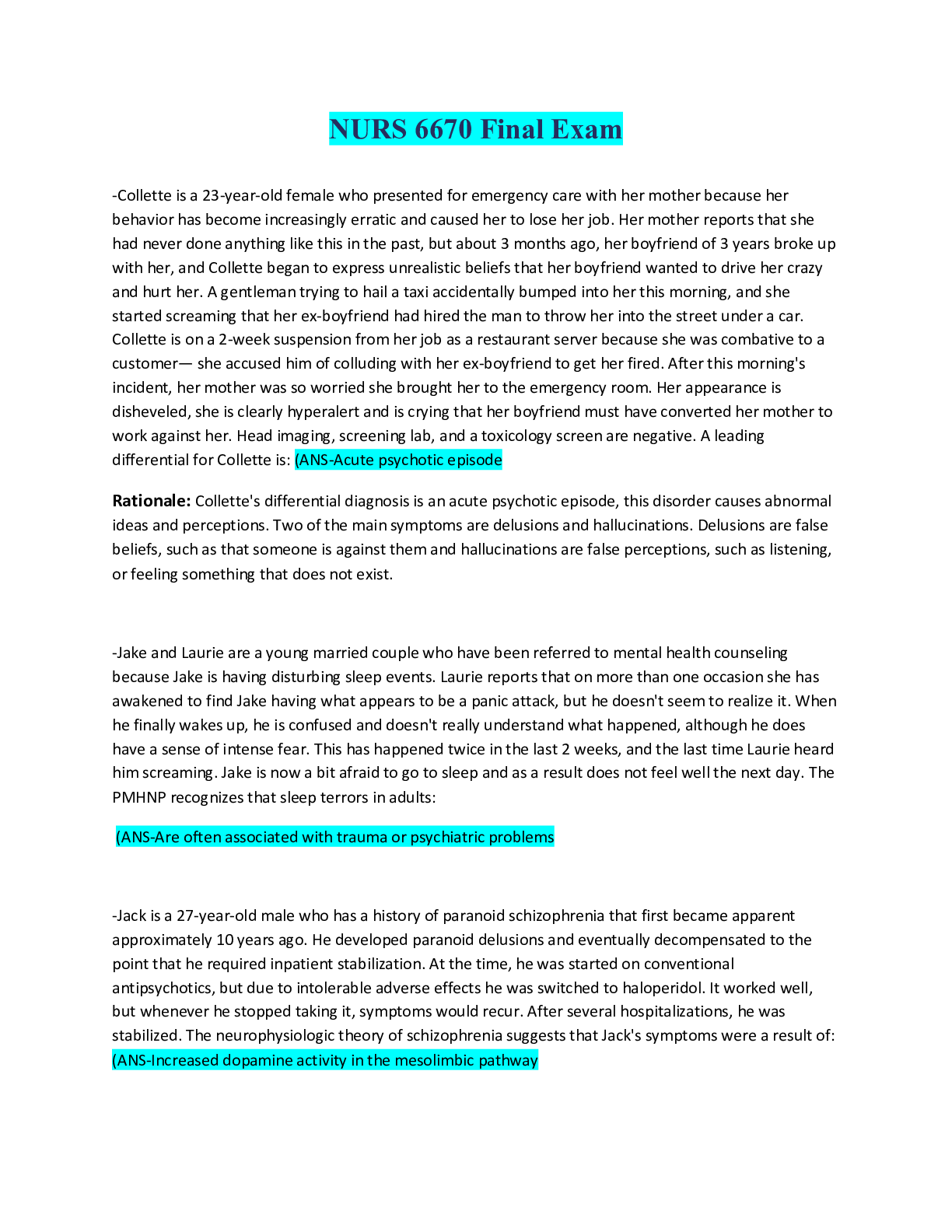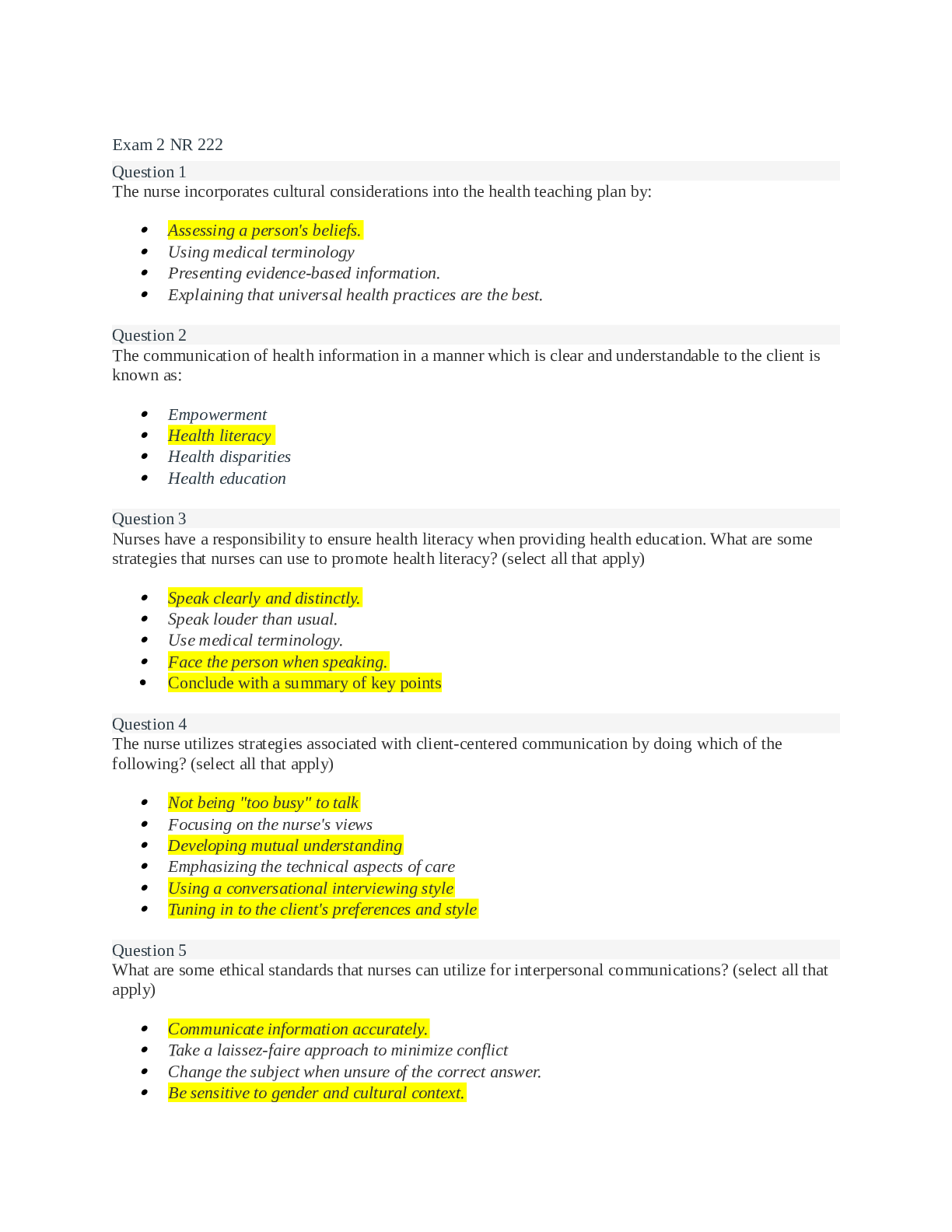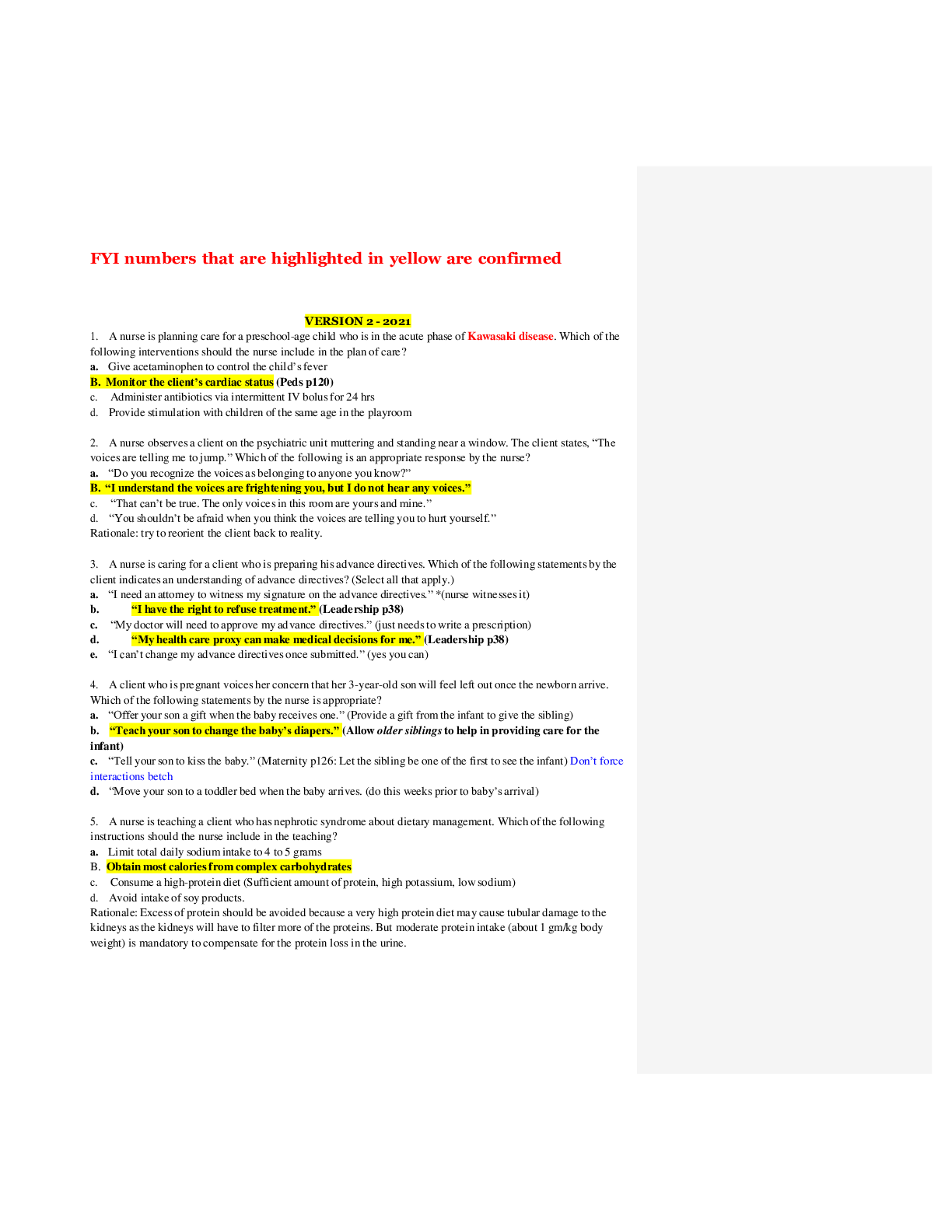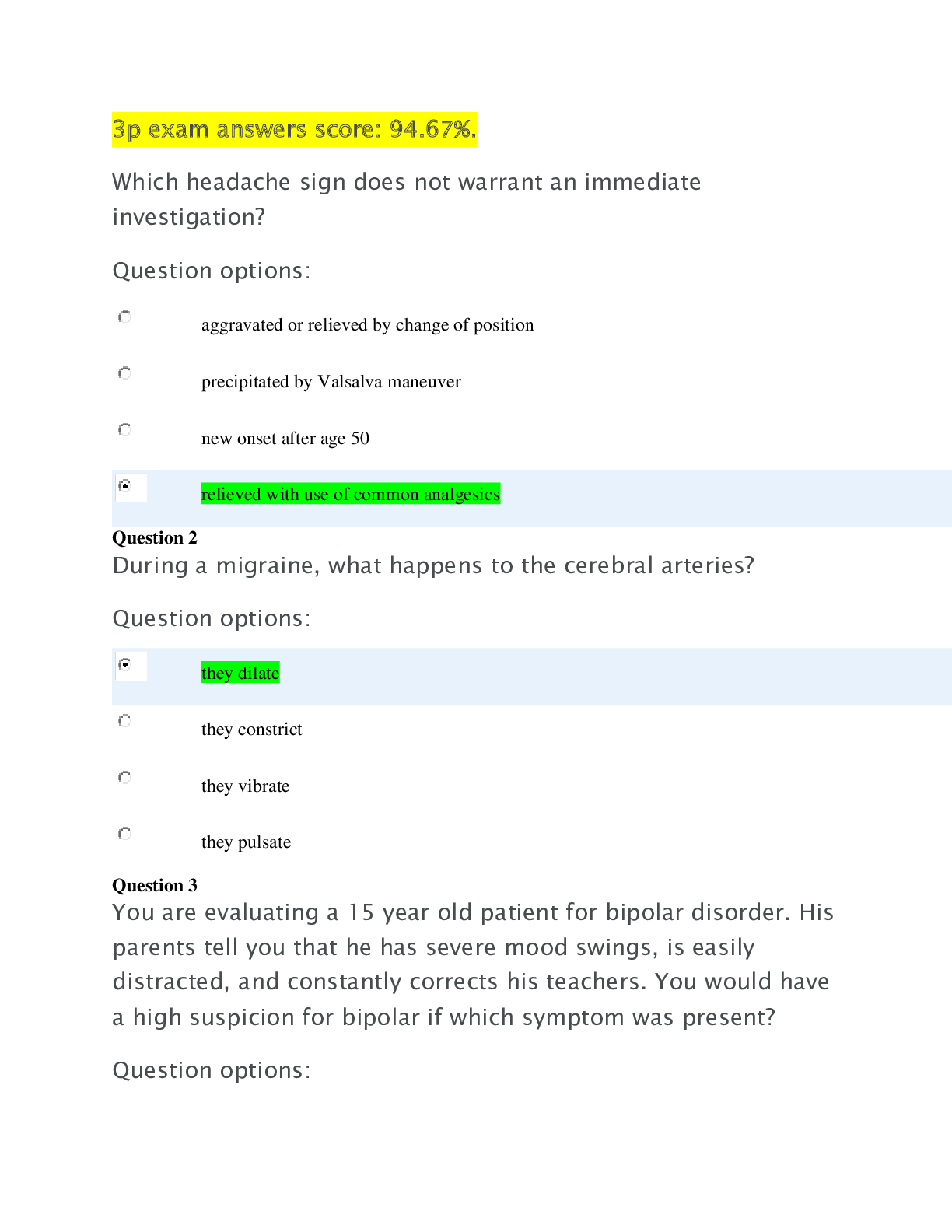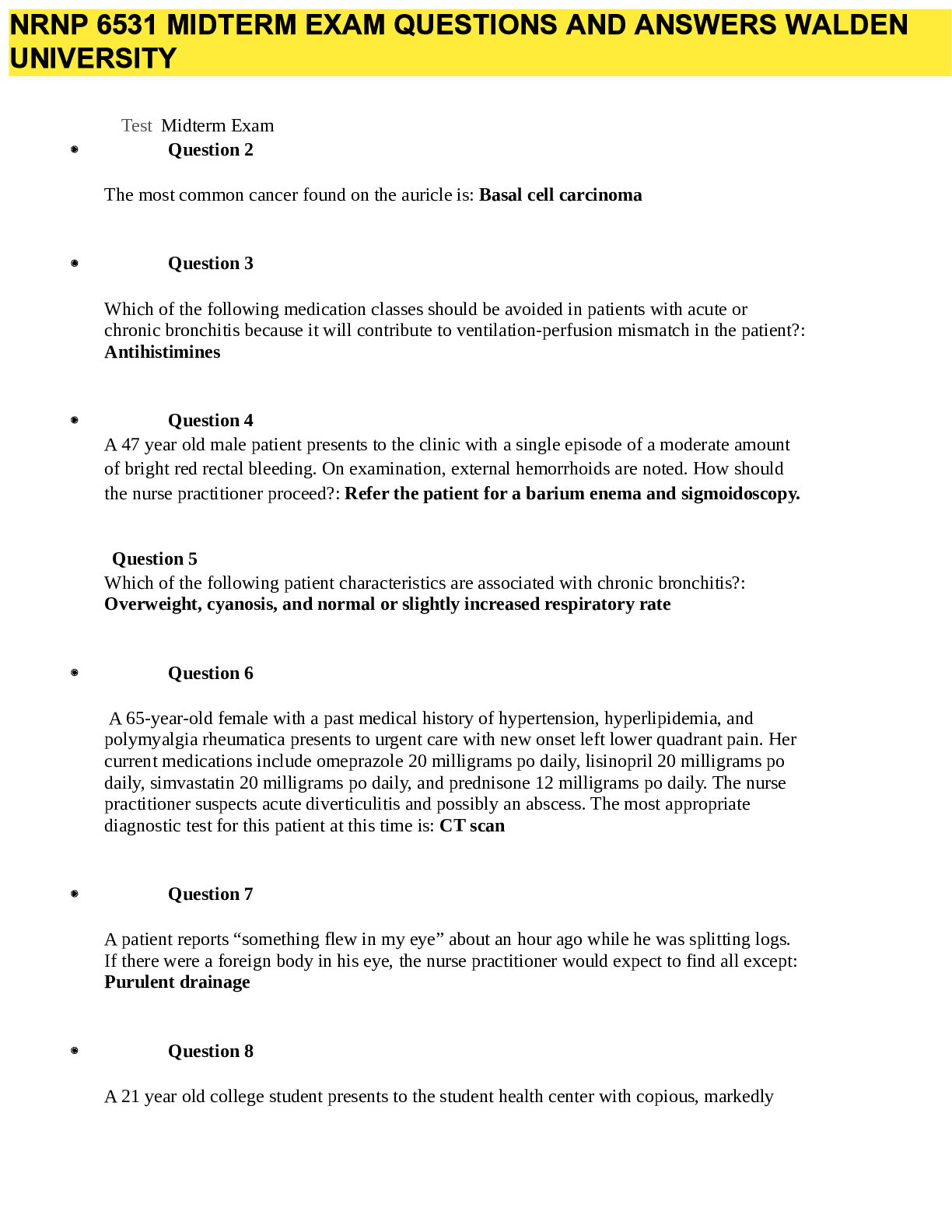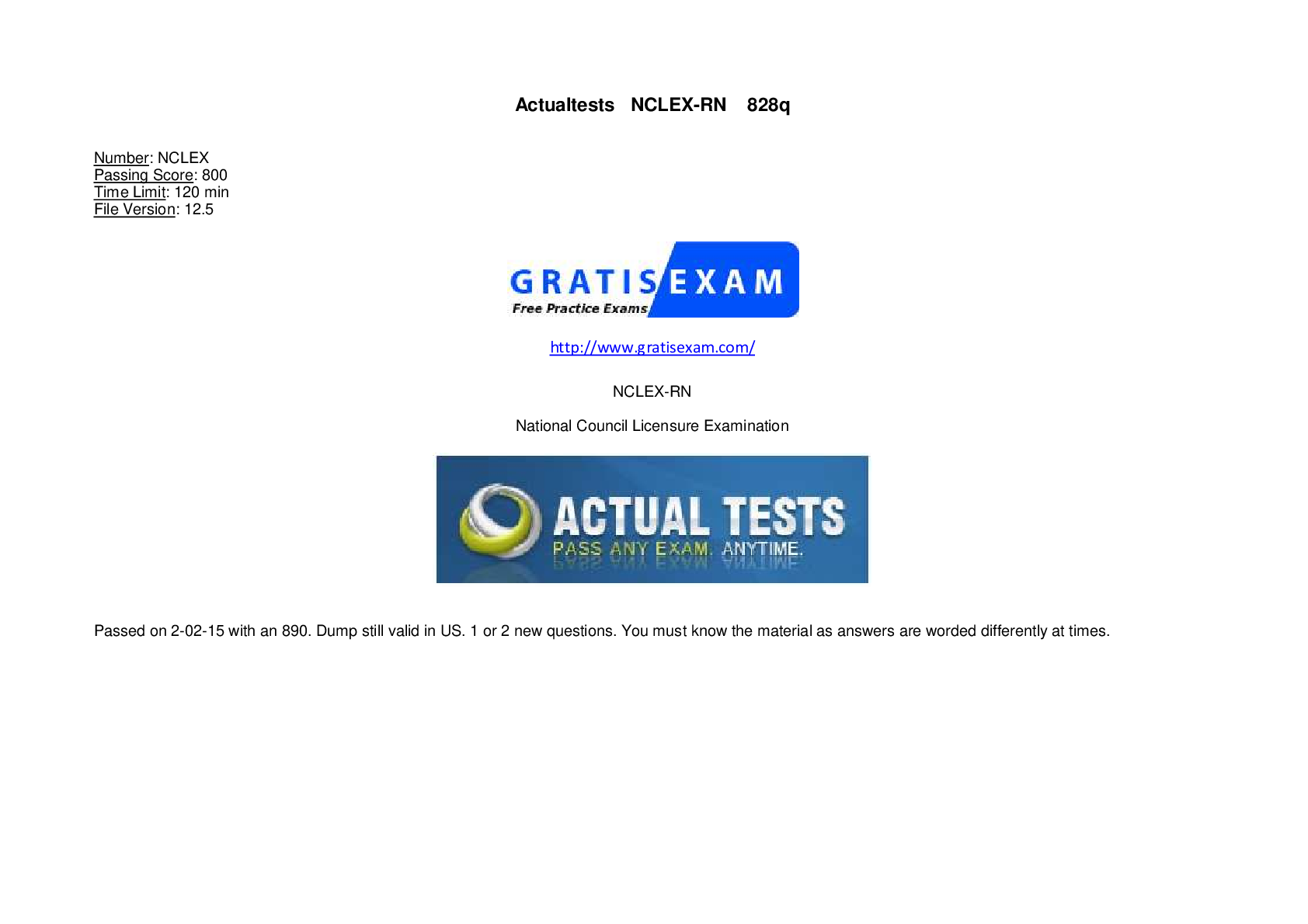Health Care > EXAM > NAPSRx Final Exam Review Solution 2021 Correct Answers | Graded A+ (correct answers highlighted in (All)
NAPSRx Final Exam Review Solution 2021 Correct Answers | Graded A+ (correct answers highlighted in yellow)
Document Content and Description Below
1. Pharmaceuticals are arguably the most socially important healthcare product. i. TRUE ii. FALSE B. Pharmaceutical development is a high-risk undertaking, in which many promising leads prove disap... pointing. i. TRUE ii. FALSE B. Pharmaceutical sales are highest in which geographical regions? i. The U.S., Saudi Arabia, and Japan ii. The U.S., Western Europe, and Japan iii. Western Europe, Australia, and Canada iv. Western Europe, Canada, and Saudi Arabia B. The U.S. accounts for about ____ of the world’s pharmaceutical revenues. i. 30% ii. 50% iii. 80% iv. 95% B. Which of the following has fueled recent growth in the pharmaceutical industry? i. increased international standardization and regulation ii. international legalization of DTC advertising iii. population growth and increased life expectancies iv. all of these B. According to your manual, which statement accurately describes the predicted relationship between pharmaceutical companies and genomic research facilities? i. "Genomic research company" is another term for "ethical research company." ii. Partnerships between pharmaceutical companies and genomic companies will not prove immediately profitable. iii. Pharmaceutical companies have little to no interest in partnerships with genomic research companies. iv. Pharmaceutical companies will be genomic research companies' biggest competitors in the coming years. B. Prescription drug therapy is not cost-effective for insurance companies and healthcare providers. i. TRUE ii. FALSE B. The high price of healthcare is explained by the high price of medicines. i. TRUE ii. FALSE B. One of the oldest and least effective pharmaceutical marketing techniques is DTC (direct-to-consumer) advertising. i. TRUE ii. FALSE B. What influences the number of districts in a region? i. the number of qualified sales representatives who apply to represent that region ii. the region's population iii. both the district's population and the number of qualified sales representatives who apply to represent that region iv. none of these B. What is an example of the regionalization of healthcare delivery systems? i. California and Florida have different demographics. ii. California and Florida have different drug companies. iii. California and Florida have different DTC advertisements. iv. California and Florida have different prescription reimbursement policies. B. The heart of a pharmaceutical sales team is the Regional Manager. i. TRUE ii. FALSE B. Most DMs did not start as representatives. i. TRUE ii. FALSE B. How many territories are in a typical district? i. 1 to 2 ii. 8 to 12 iii. 30 to 40 iv. 50 to 100 B. What is the most effective method for grabbing market share? i. comparative selling ii. criticizing the competition iii. power point presentations iv. questioning doctors' choices Quiz 2 , Chapter 2 & 3 1. Pharmaceutical reps mainly visit pharmacies. i. TRUE ii. FALSE B. It usually only takes 1-2 calls to a physician before he or she commits to prescribing your product. i. TRUE ii. FALSE B. The pharmacist may dispense a product other than what the physician prescribed i. TRUE ii. FALSE B. According to Chapter 12 of your manual, which of the following would classify as "payers"? i. employers ii. patients iii. pharmacists iv. physicians B. According to your manual, what defines "ethical pharmaceutical companies"? i. donating a specified proportion of their revenue to consumer organizations ii. donating a specified proportion of their revenue to the NIH iii. manufacturing generics iv. researching and developing novel drugs B. One of the most disappointing results of the pharmaceutical industry’s continued investment in R & D is the few new drugs being approved and in development. i. TRUE ii. FALSE B. Thanks to modern medicines, how long are people newly diagnosed with HIV expected to live? i. another 10 years ii. another 20 years iii. another 5 years iv. another 50 years B. How much has the average American lifespan increased since 1890? i. almost 10 years ii. almost 15 years iii. almost 30 years iv. almost 5 years B. What is a treatment group? i. a group of patients assigned to receive a specified treatment ii. a group of patients who have volunteered to receive the active drug, but not the placebo iii. A group of substances being tested iv. A list of study protocols B. What is the main difference between a blinded and double-blinded study? i. A blinded study is performed to control the placebo effect whereas a double-blinded study is performed to control the observer effect. ii. A double-blinded study has two control groups, but a blinded study only has one. iii. Blinded studies are more scientifically rigorous. iv. In a double blinded study, neither the study staff nor the study participants know which subjects are in the experimental group and which are in the control. B. What does "asymptomatic" mean? i. exhibiting atypical signs or symptoms that were not indicated in the product packaging ii. not exhibiting signs or symptoms iii. refusing treatment for symptoms iv. toxic or harmful to the human body Quiz 3 , Chapter 4 1. Which term denotes the study of bodily functions (as opposed to structures)? i. anatomy ii. cytology iii. oncology iv. physiology B. In its broadest definition, a drug is any substance that produces a physical or psychological change in the body. i. TRUE ii. FALSE B. How does the Federal Food, Drug and Cosmetic Act (FFDCA) define a drug? i. any substance intended for use in the diagnosis, cure, mitigation, treatment or prevention of disease, or a substance other than food intended to affect the structure or function of the body ii. any substance that causes legitimate side effects iii. any substance that outperforms a placebo iv. any substance that produces a physical or psychological change in the body B. Which statement about vitamins is CORRECT? i. Most of the body's required vitamins are manufactured in the bone marrow. ii. Most of the body's required vitamins are products of the body's metabolic processes. iii. Most of the body's required vitamins must be taken in from outside the body. iv. The body manufactures most of the vitamins it requires. B. ADME testing measures the rate at which the body absorbs the drug, distributes it to the organs necessary to produce the desired effect, metabolizes it into waste material and then excretes it from the body. i. TRUE ii. FALSE B. ADME testing is primarily used in what field? i. epidemiology ii. epigenetics iii. pharmacodynamics iv. pharmacokinetics B. Which statement about placebos is CORRECT? i. By definition, placebos must b designed to affect everyone equally. ii. Placebo effects can be distinguished from drugs because they are always desirable. iii. Placebo effects can lead to withdrawal symptoms. iv. Placebos can be distinguished from drugs because they do not lead to withdrawal symptoms. B. On average, only about 5 of 4,000 drugs studied in the laboratory are eventually studied in people. i. TRUE ii. FALSE B. Which statement is TRUE about drugs taken sublingually? i. Sublingual administration is the most common route of administration. ii. Sublingual drugs are absorbed directly and almost immediately into the bloodstream. iii. Sublingual drugs are used primarily to treat the mouth. iv. Sublingual drugs must first pass through the intestinal wall and liver, just like oral drugs, but can be used in patients with swallowing problems. B. What are 3 of the 7 rights of drug administration? i. the right patient, the right drug, and the right dose ii. the right supervision, the right patient, and the right dose iii. the right technique, the right documentation, and the right supervision iv. the right to information about one's medication, the right to question one's treatment, and the right to a second opinion B. Pro-drugs are administered in an active form, which is metabolized into an inactive form. i. TRUE ii. FALSE B. The kidney of an 85-year-old person excretes drugs only _____ as efficiently as that of a 35-year-old person. i. around 15% ii. around 30% iii. around 50% iv. This is impossible to predict because it depends on such a wide range of other factors. B. The normal age-related decrease in kidney function can help doctors determine an appropriate dosage based solely on a person’s age. i. TRUE ii. FALSE B. What DIFFERENTIATES a caplet from a tablet? i. Caplets are made of compressed powder. ii. Caplets are shaped like capsules and have film coatings to aid in swallowing. iii. Caplets are used for sustained-release drugs. iv. Caplets contain hard cylindrical granules, liquids, or some combination of these. B. Where will you find the legend “Caution: Federal Law prohibits dispensing without a prescription”? i. on the label of all prescription drugs ii. on the labels of all generic drugs iii. only on the labels of drugs dispensed at pharmacies (as opposed to, e.g., product samples at doctors' offices) iv. only on the labels of product samples B. What happens in slow acetylators? i. Drugs that are metabolized by N-acetyl transferase are less likely to reach toxic levels than in fast acetylators. ii. Drugs that are metabolized by N-acetyl transferase tend to reach higher blood levels and remain in the body longer. iii. Drugs that are metabolized by N-acetyl transferase tend to reach lower blood levels, but remain in the body longer. iv. None of these statements apply to slow acetylators. Quiz 4 , Chapter 4 1. About _____ of the people in the U.S. are "slow acetylators." i. 1% ii. 5% iii. 25% iv. 50% B. Which of the following statements about drug-drug interactions is INCORRECT? i. Drug-drug interactions are always harmful. ii. Duplication can involve two drugs with the same effect causing toxicity when taken together. iii. Duplication can involve two drugs with the same effect intensifying each other's therapeutic effects without any serious side effects. iv. Opposition can involve two drugs with opposing actions interacting to reduce one's effectiveness but not the other's. B. Smoking decreases the effectiveness of some drugs. i. TRUE ii. FALSE B. Which of the following statements about dietary supplements is INCORRECT? i. Because dietary supplements are not drugs, interactions with drugs are not a concern. ii. Dietary supplements are regulated as foods. iii. Dietary supplements contain vitamins, minerals, amino acids, and/or herbs. iv. all of these B. Which statement/s is/are INCORRECT about an ideal drug, or "magic bullet" as Ehrlich phrased it? i. It does not exist. ii. It would be aimed precisely at a disease site. iii. It would not harm healthy tissues. iv. All of these statements are correct. B. Which statement accurately differentiates resistance from tolerance? i. Doctors can predict resistance but not tolerance. ii. There is no difference between tolerance and resistance. iii. Tolerance is caused by genetic mutations, but resistance is always innate. iv. Tolerance refers to a person's diminished response to a drug after repeated use, while resistance applies to microorganisms' or "cancel" cells' abilities to withstand drug effects. B. Between 3% and 7% of hospital admissions in the United States are estimated to be for treatment of adverse drug reactions. i. TRUE ii. FALSE B. Which statement is true about the universal scale for quantifying the severity of an adverse drug reaction? i. The severities of adverse drug reactions are quantified by their chronicity. ii. The severities of adverse drug reactions are quantified by their threat to life. iii. None of these statements are true because the scale uses different criteria. iv. None of these statements are true because there is no such scale. B. Why is noncompliance a serious public health concern? i. It erodes trust between physicians and pharmaceutical sales representatives. ii. It increases the cost of medical care. iii. It indicates a lack of accountability among healthcare providers. iv. Noncompliance is a serious public health concern for all of these reasons. B. Which of the following is NOT eligible for patent protection under U.S. regulations? i. the drug itself ii. the method of delivering and releasing the drug into the bloodstream iii. the way the drug is made iv. Companies can be granted patents for all of these things. B. Drugs' trade names are often unrelated to their intended use. i. TRUE ii. FALSE B. Like foods and household products, generic drugs are usually lower quality than the brand name drugs for which they are marketed as equivalents. i. TRUE ii. FALSE B. Legally, bioequivalence of different versions of a drug can vary by up to ________. i. 3.50% ii. 10% iii. 20% iv. The drugs must be 100% equivalent. B. Which of the following statements about biologics is INCORRECT? i. They are also called “large molecule" drugs. ii. They are derived from living materials. iii. They do not cause immune responses. iv. Vaccines are a type of biologic. B. “Large molecule” products are developed and manufactured by a chemical process. i. TRUE ii. FALSE B. What are drugs that attract or bind to cell receptors in order to mimic or enhance activities by endogenous chemical messengers? i. agonists ii. antagonists iii. orphan drugs iv. steroids Quiz 5 , Chapter 4 1. Which term denotes how an API works in the body? i. formulation ii. mechanism of action iii. site of action iv. therapeutic group B. What cements the active and inert components together to maintain cohesive portions? i. binders ii. colors iii. disintegrants iv. lubricants B. What does the medical abbreviation "BID" denote? i. as needed ii. bioavailable in diet iii. quality of drugs iv. twice a day B. What is the medical abbreviation for "as needed"? i. BID ii. PRN iii. PSN iv. QID B. Which components might cause patients' different reactions to brand name and generic drugs? i. differences in active ingredients ii. differences in inactive ingredients iii. differences in both active and inactive ingredients iv. Patients' reactions to a brand name and generic drugs are equivalent. B. All cells have a nucleus. i. TRUE ii. FALSE B. Which of the following does NOT affect drug response? i. the patient's genetic makeup, age, body size, and use of other drugs and dietary supplements. ii. the patient's other conditions or diseases. iii. whether or not the patient takes the drug properly iv. All of these factors influence drug response. B. Drug reactions are predictable because they do not occur after a person has been previously exposed to the drug one or more times without any allergic reactions. i. TRUE ii. FALSE B. What is the typical relationship between a drug's site of administration and site of action? i. They are usually somewhat removed from each other. ii. They are usually the same site. iii. They should not be the same site for economic reasons. iv. They should not be the same site for safety reasons. B. What is CMAX? i. an abbreviation for the maximum concentration of white blood cells ii. the peak plasma concentration on a measuring curve iii. the time interval within which a given dose of a drug is expected to have a therapeutic effect iv. the time of peak plasma concentration on a measuring curve B. Which of the following is NOT a main concept in clinical pharmacology? i. Drug Distribution and Elimination ii. Pharmacodynamics iii. Pharmacokinetics iv. Pharmacoprocesses B. Which of the following is NOT a route of drug administration? i. buccal ii. Intramuscular iii. sublingual iv. transfugal B. How are intradermal drugs delivered? i. by injection under the skin ii. through a skin patch iii. through a topical ointment iv. under the tongue B. What is an example of intravenous drug delivery? i. a subcutaneous insulin injection ii. a transdermal nicotine patch iii. an injection of anesthetic directly into the bloodstream iv. any type of pre-surgery anesthetic B. What are the major organs of the gastrointestinal system? i. the heart, the blood vessels, and the blood ii. the lymph nodes and lymph vessels iii. the mouth, esophagus, stomach, liver, pancreas, gallbladder, small and large intestines iv. the nasal passages, the trachea, the diaphragm, and the lungs Quiz 6 , Chapter 5 & 6 1. Who is normally responsible for selling to distributors? i. Floaters ii. Local Territory Representatives iii. NAMs iv. Pharmacy Benefit Managers B. How often do secondary drug wholesale distributors buy their drugs directly from manufactures? i. always ii. almost always iii. sometimes iv. never B. By FDA law, large chain pharmacies are not allowed to buy directly from drug manufactures. i. TRUE ii. FALSE B. Only 3 companies account for nearly 90% of all drug wholesale sales. i. TRUE ii. FALSE B. What type of sale bypasses the need for intermediary distributors? i. brokerage sales ii. drop shipment sales iii. integrated delivery network sales iv. manufacturer-direct sales B. What is a group purchasing organization (GPO)? i. a company that owns and operates 3 or fewer pharmacies ii. a wholesaler that obtains drugs from manufacturers and delivers them directly to pharmacists' warehouses iii. an entity consisting of two or more hospitals or other health care entities that negotiates contracts on behalf of its members iv. any distributor of a prescription drug that conducts at least 22 transactions every 2 years B. Prescriptions dispensed by mail-order pharmacies are, on average, around ____________ than those dispensed by retail pharmacies. i. 3 times smaller ii. just slightly smaller iii. 3 times larger iv. 10 times larger B. Which of the following is NOT a type of non-stock sale? i. brokerage sales ii. dock-to-dock sales iii. drop shipments iv. All of these are examples of non-stock sales. B. What is another term for rebates? i. after-market arrangements ii. in-state arrangements iii. mail-order arrangements iv. sell-side arrangements B. The PDMA is the Prescription Drug Manufacturers Association. i. TRUE ii. FALSE B. A company that owns and operates three or fewer pharmacies is an ____________. i. authorized distributor ii. independent drug store iii. in-state wholesaler iv. integrated drug store B. Which section of a drug's package insert information covers the usual dosage range? i. clinical pharmacology ii. contraindications iii. description iv. indications and usage B. Drug labels must include indications, usage information, and contraindications. i. TRUE ii. FALSE B. What should be included in the "description" section of a drug's package insert information? i. the drug's proprietary name and the established name ii. the indications iii. the mechanism of action iv. warnings Quiz 7 , Chapter 7 Please enter your name and email address below. The quiz results will be displayed immediately after submission and also will be emailed to the email address entered below. NAPSRx® does not keep a record of your quiz scores so please keep a record of your own scores. Name: * Email: * 1. Exclusivity gives exclusive _____, is granted by the FDA, and can run concurrently with a patent or not. i. marketing rights ii. research work iii. trademark assignment iv. values B. What differentiates exclusivity from a patent? i. Exclusivity can be granted at any time during a drug's lifespan. ii. Exclusivity can encompass a wide range of claims, whereas patents do not. iii. Exclusivity is only granted upon the drug's FDA approval. iv. Exclusivity typically lasts longer than patents. B. What is required of an inven [Show More]
Last updated: 1 year ago
Preview 1 out of 34 pages
Instant download
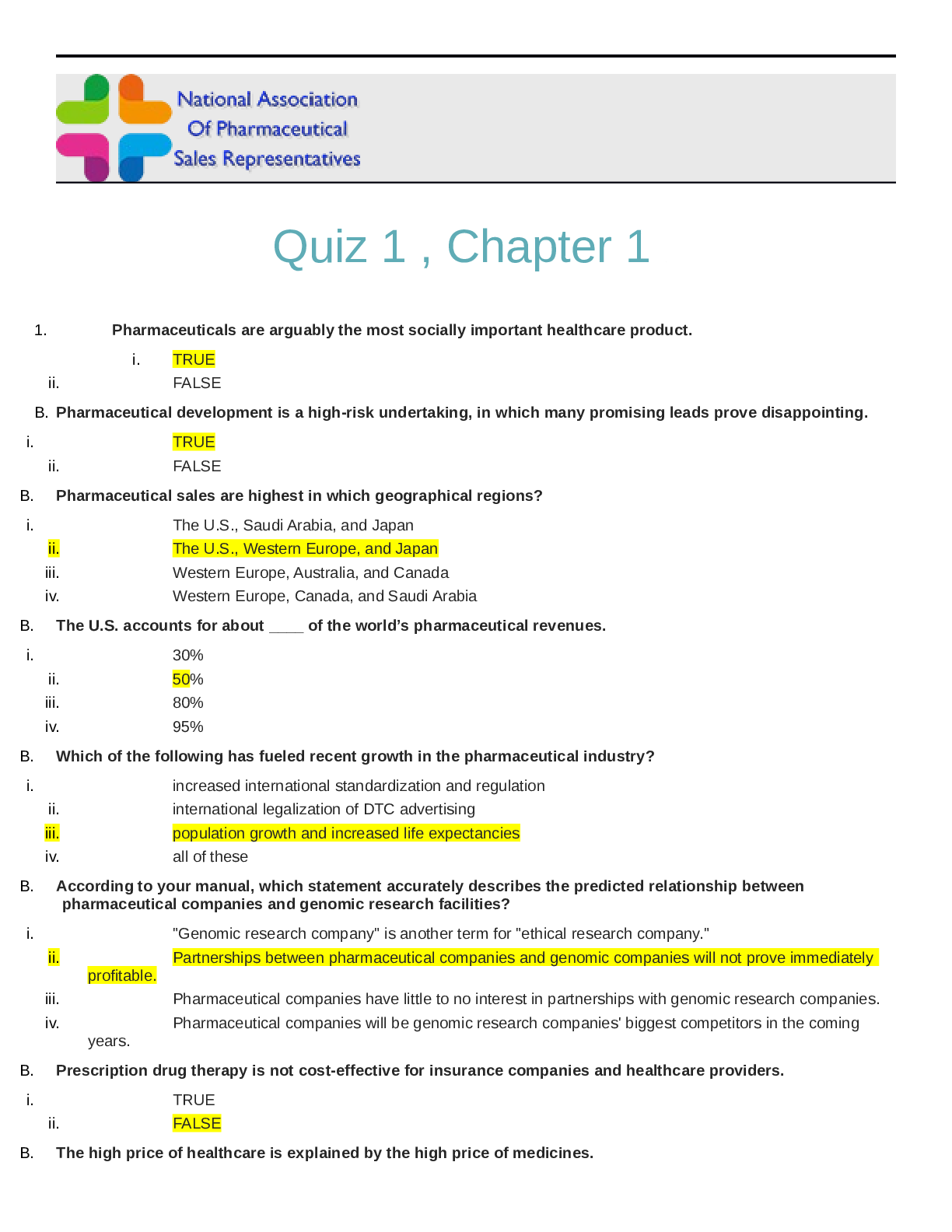
Instant download
Reviews( 0 )
Document information
Connected school, study & course
About the document
Uploaded On
Sep 20, 2021
Number of pages
34
Written in
Additional information
This document has been written for:
Uploaded
Sep 20, 2021
Downloads
0
Views
197

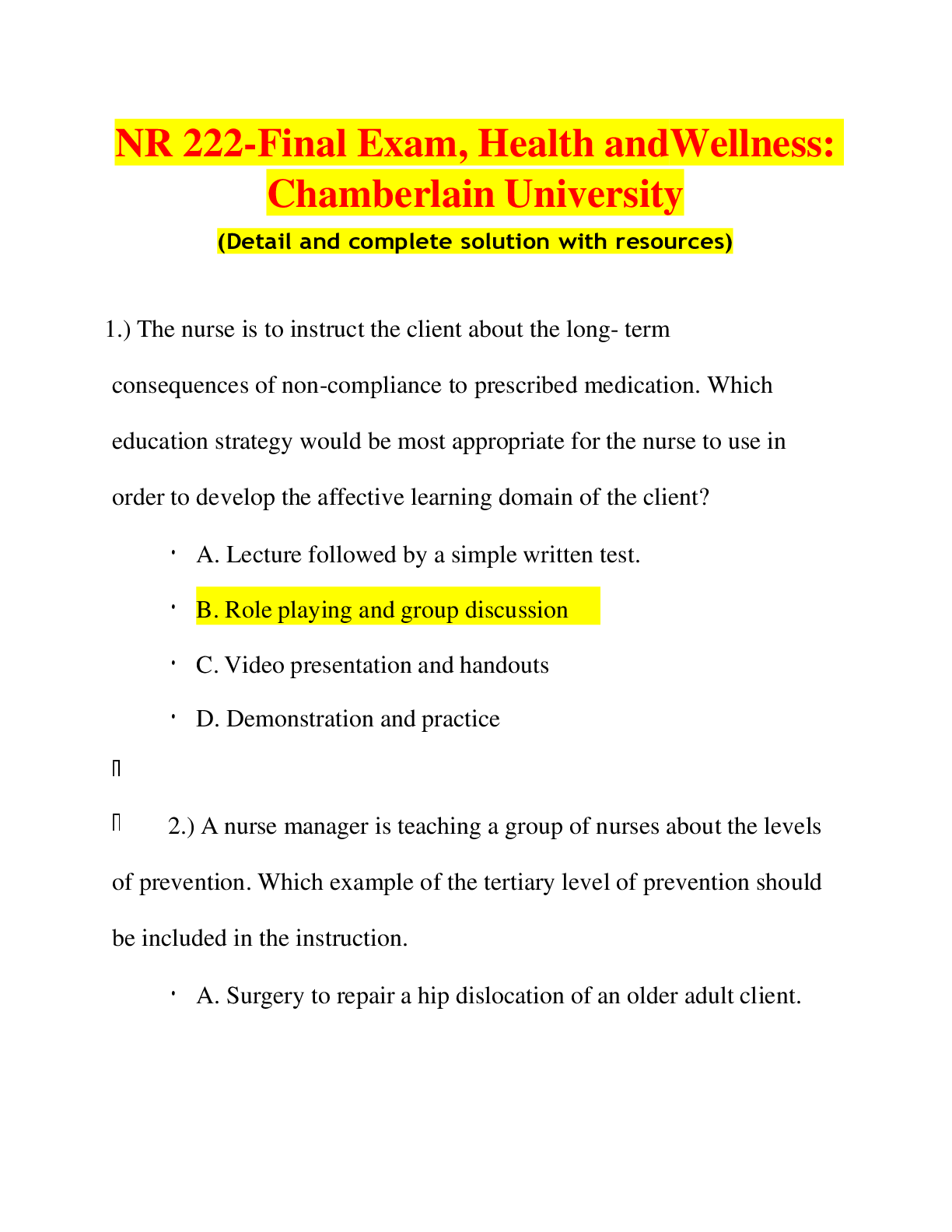
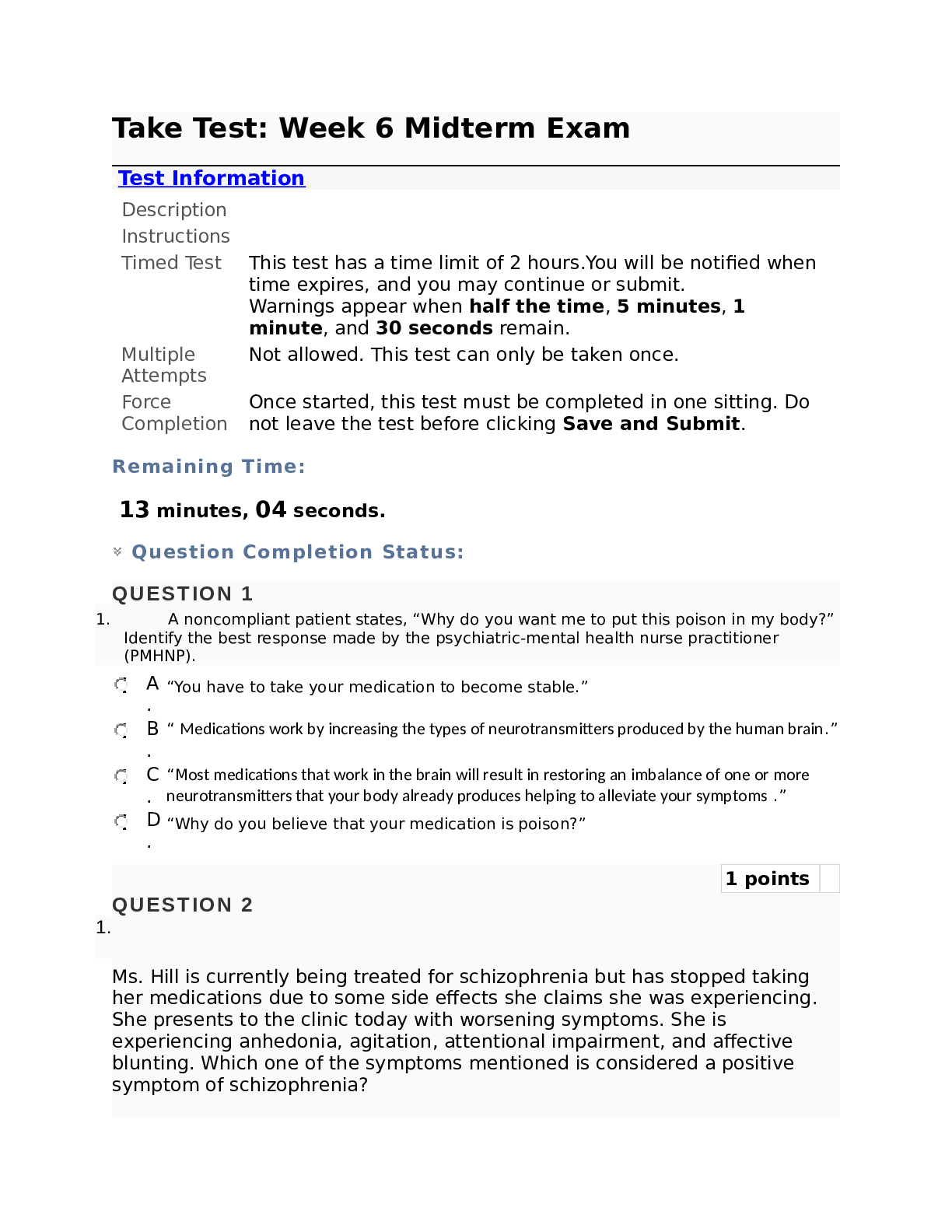
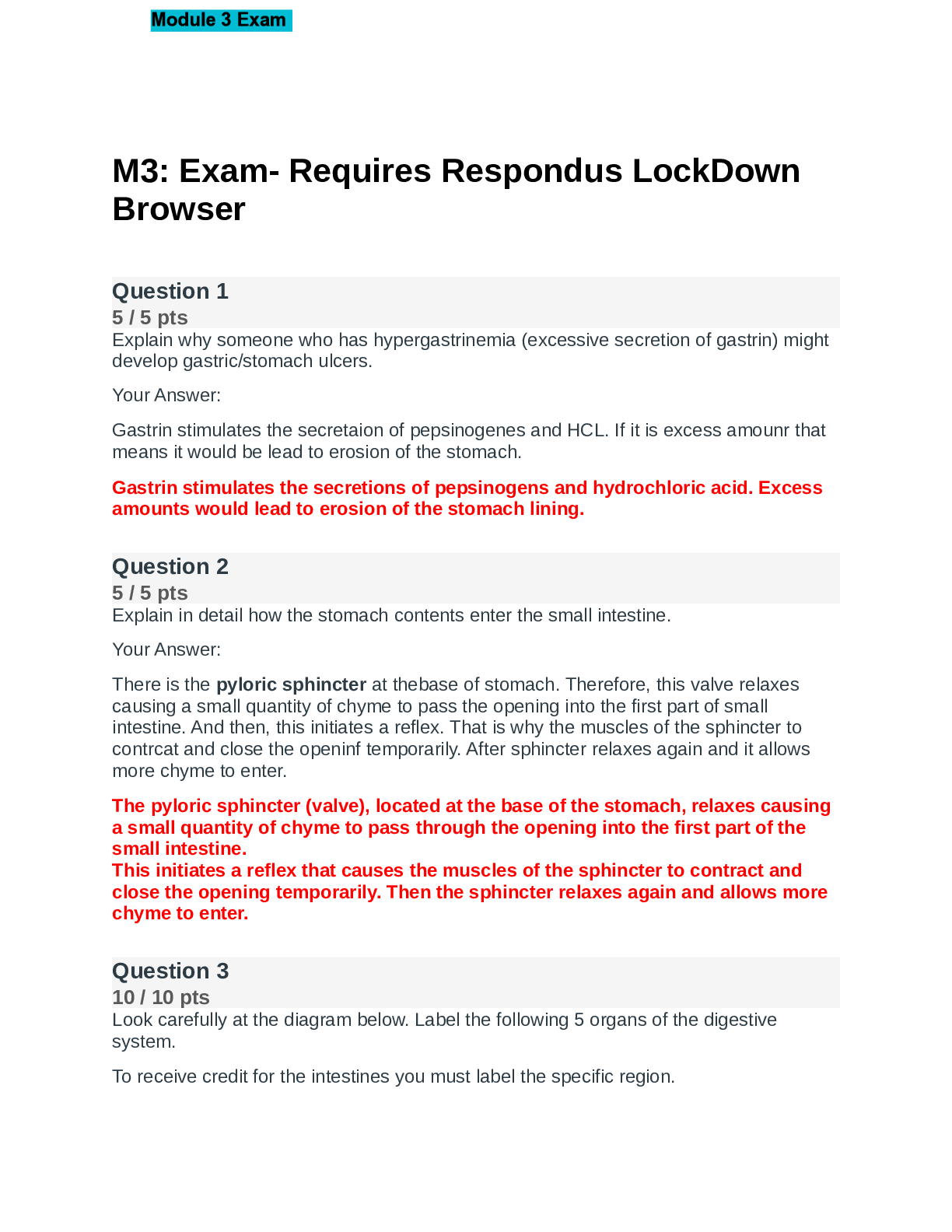

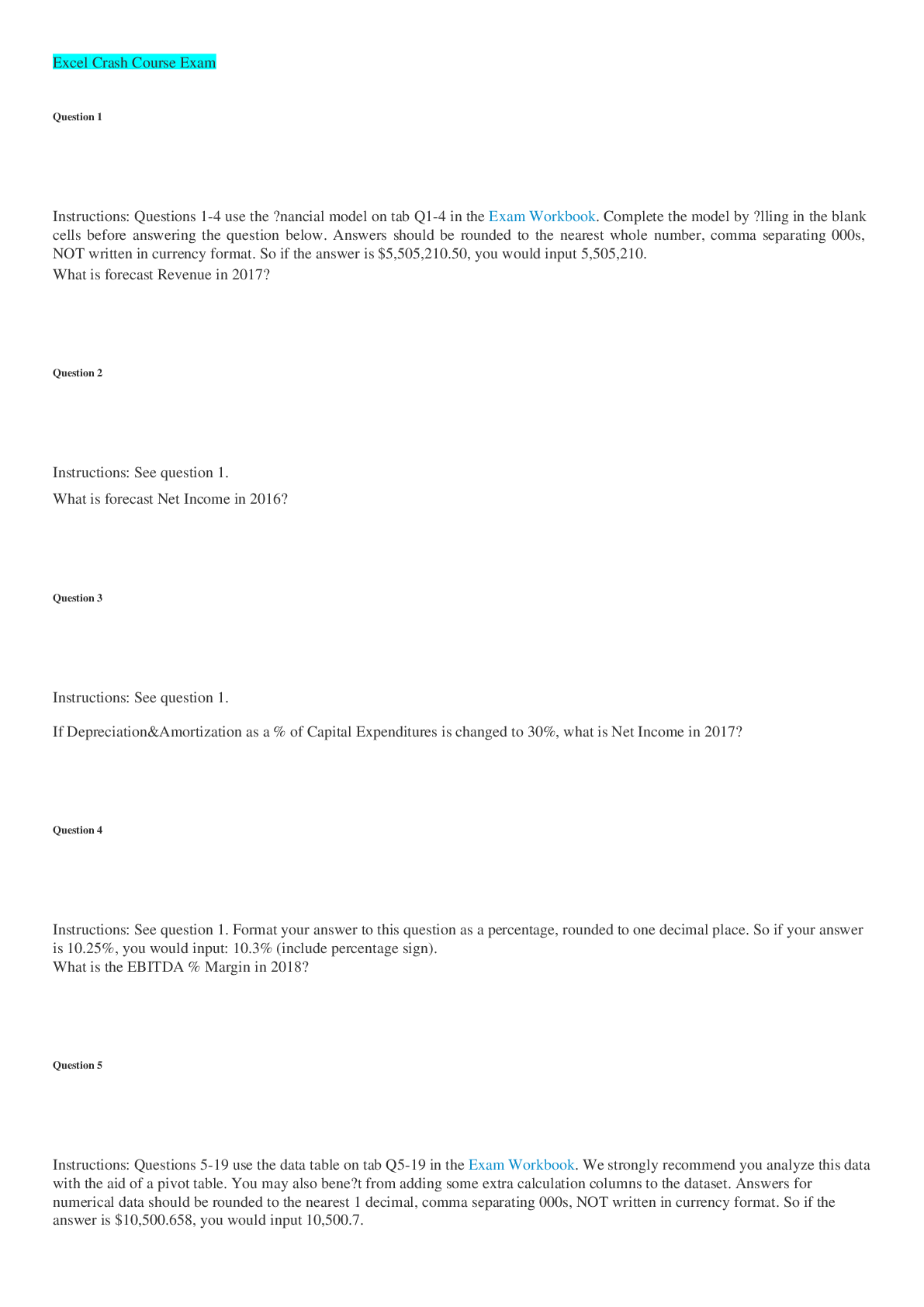

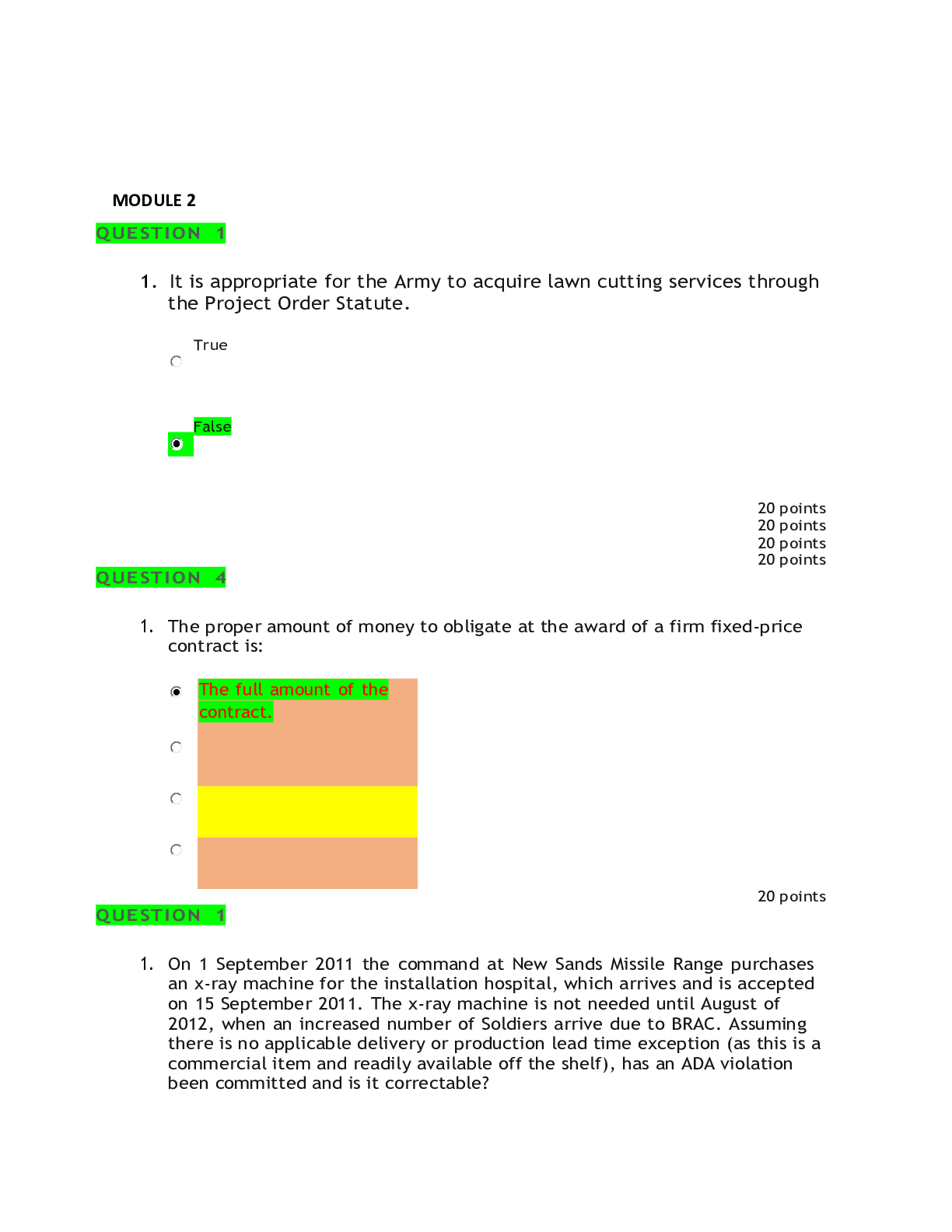

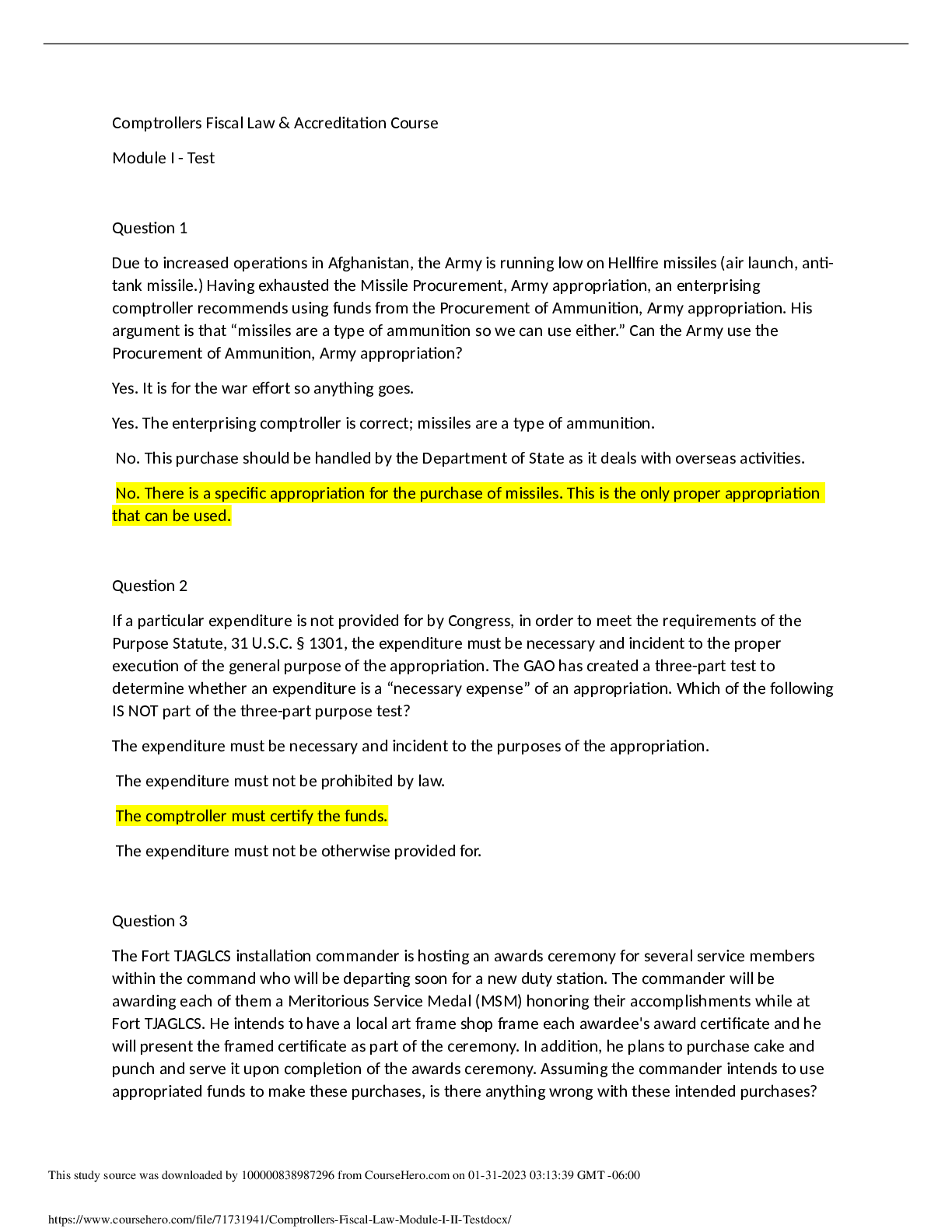
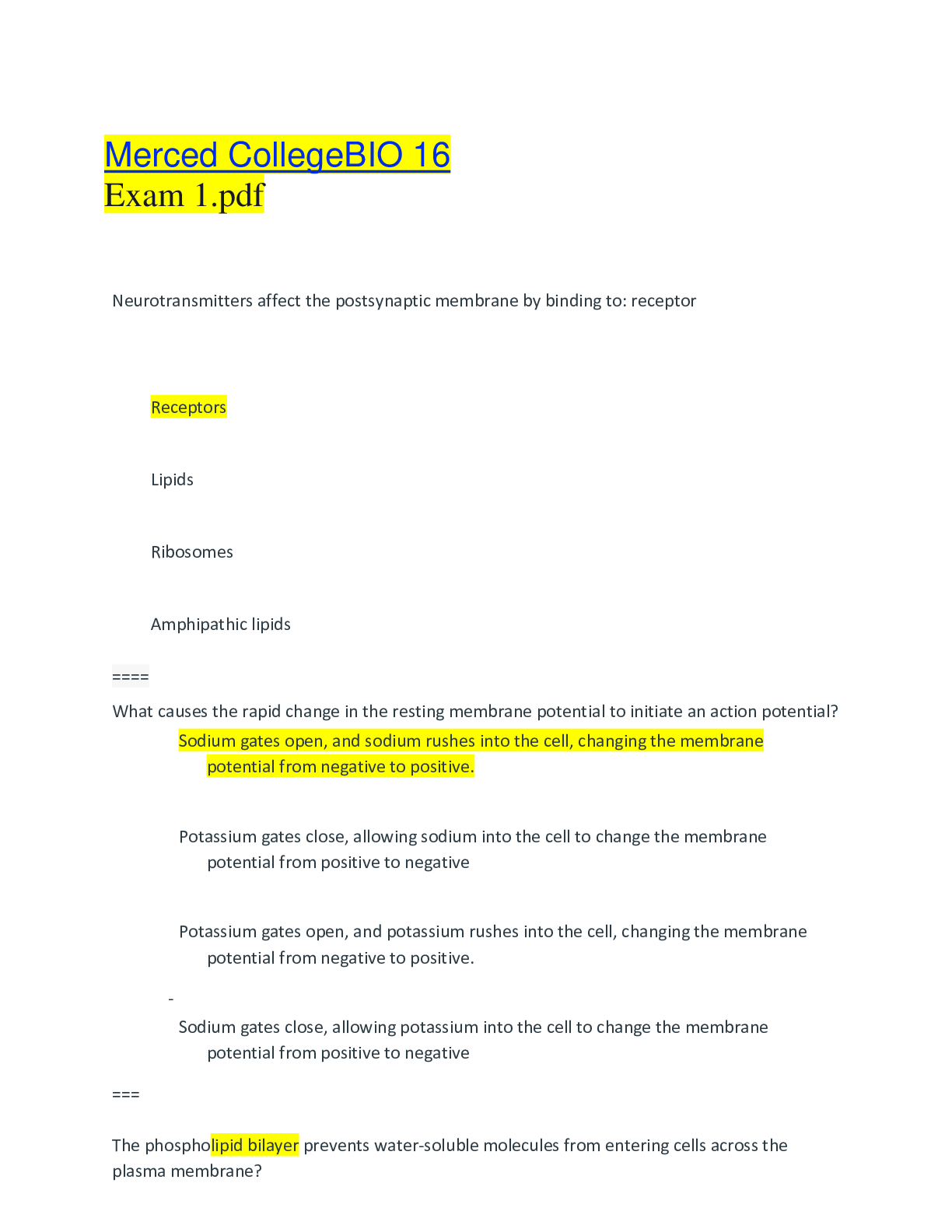
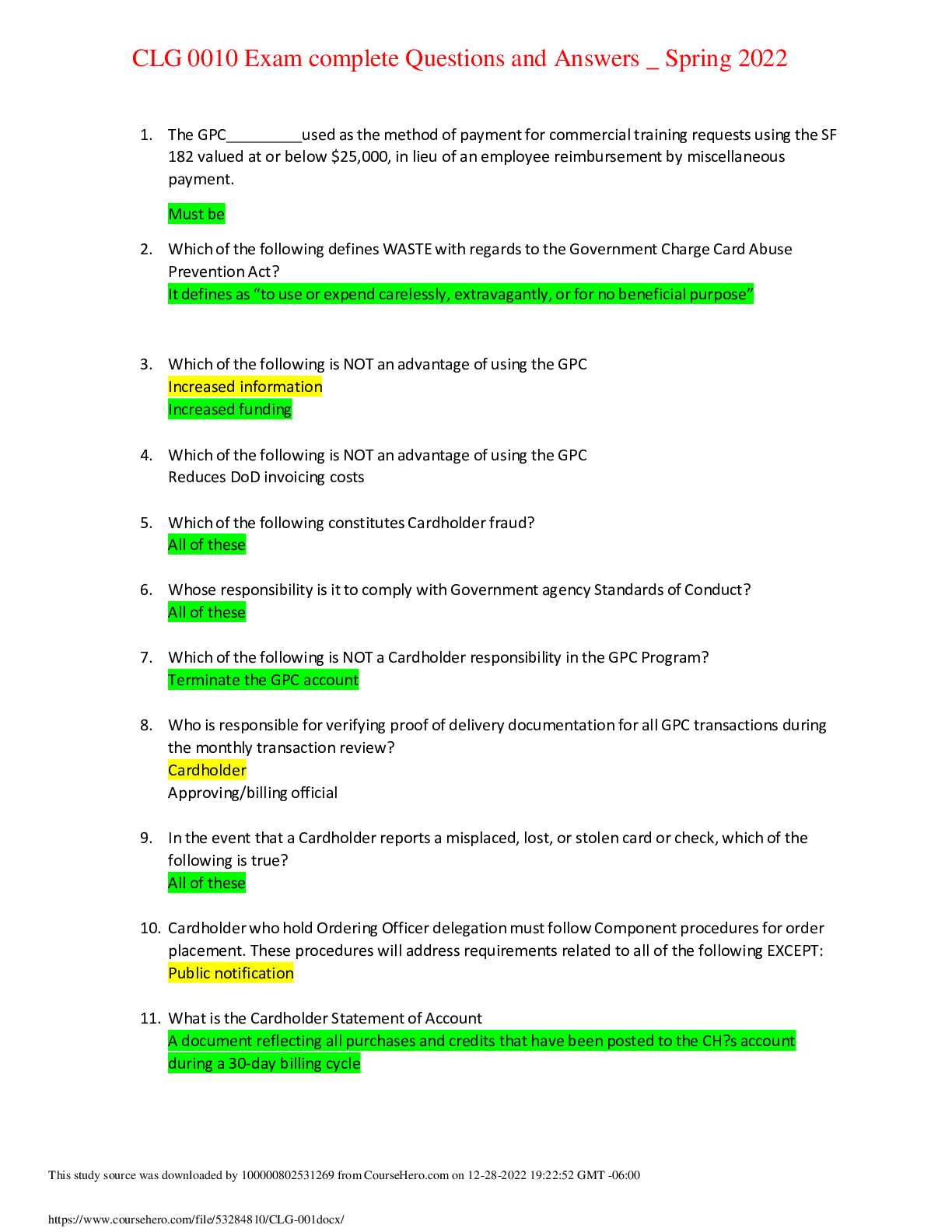
.png)

